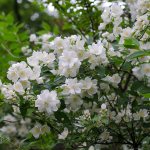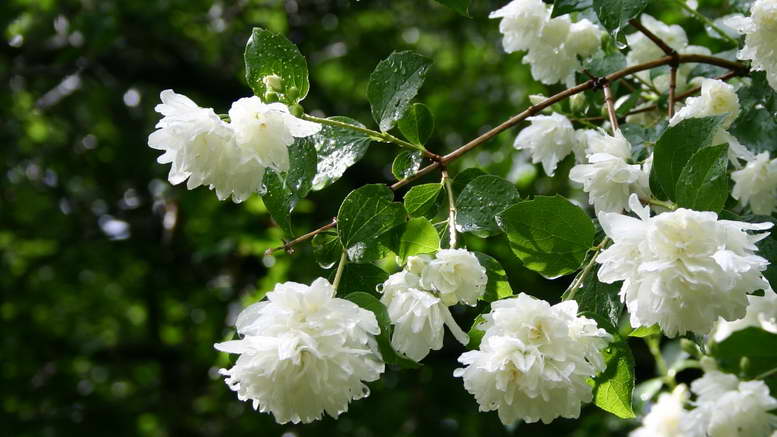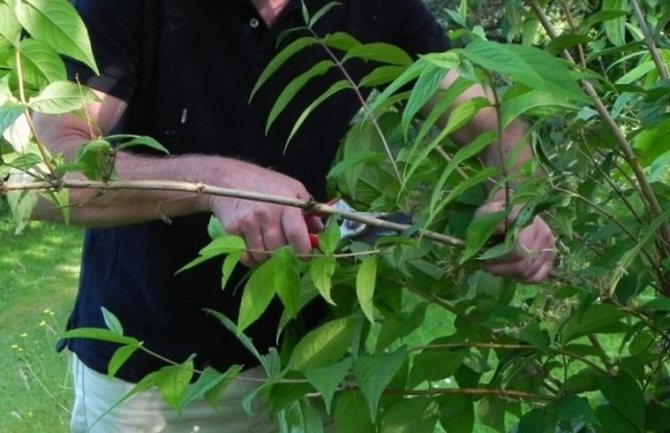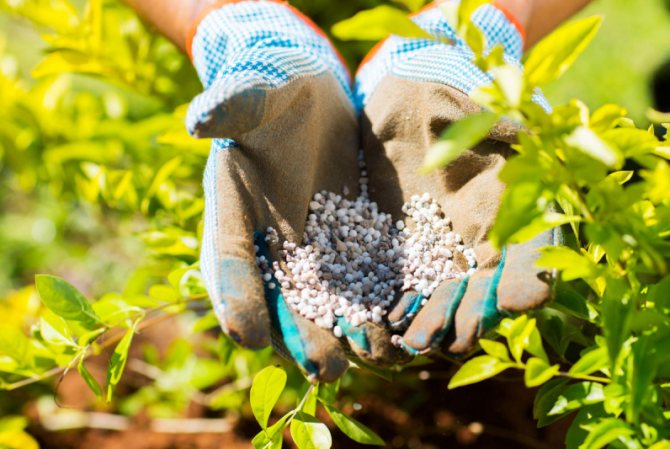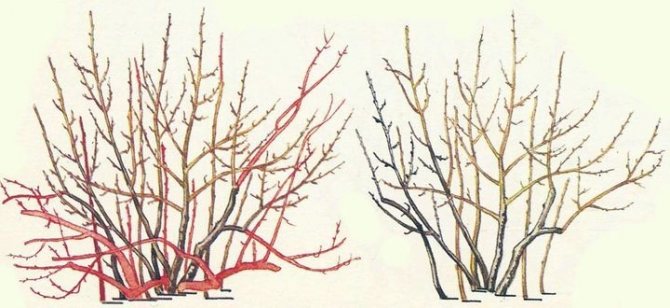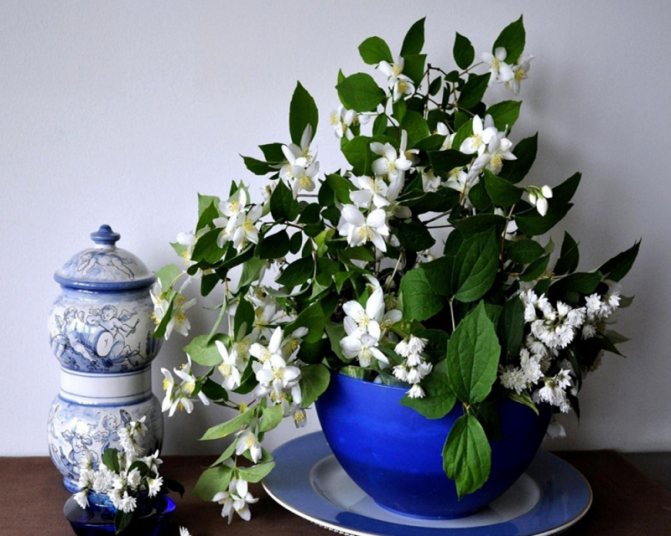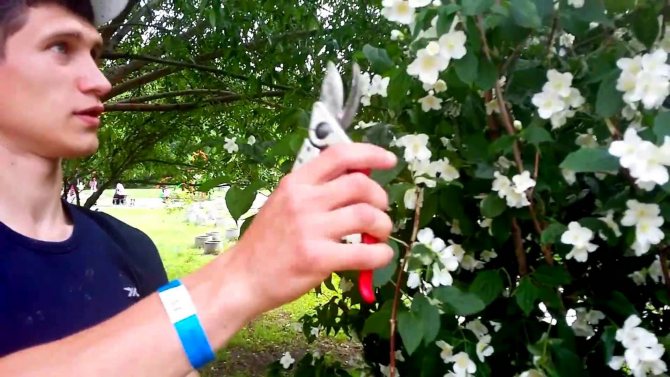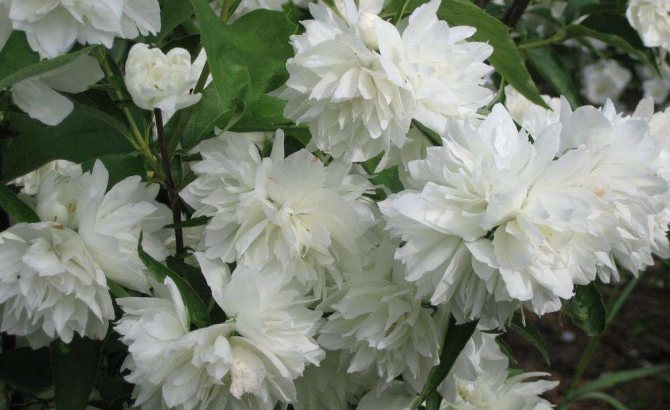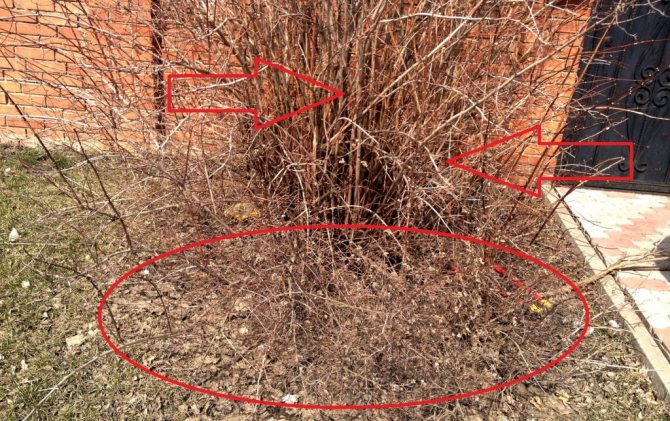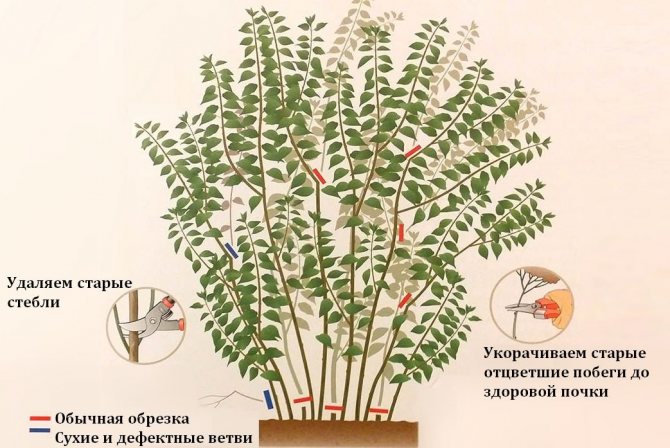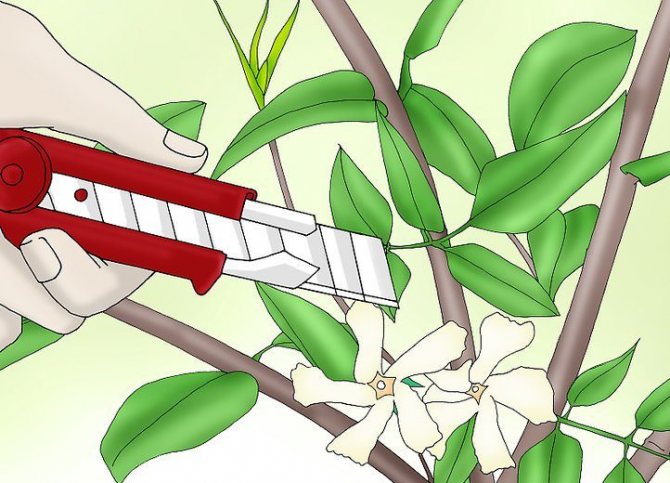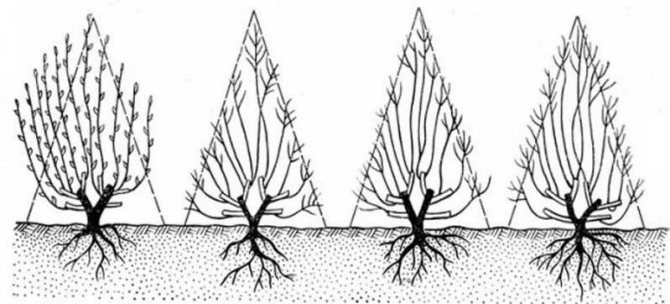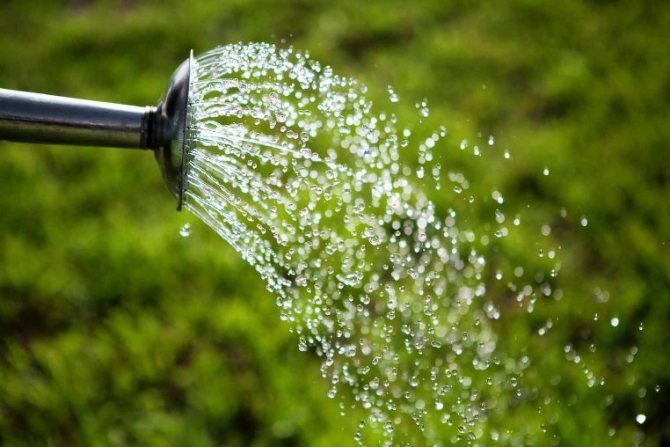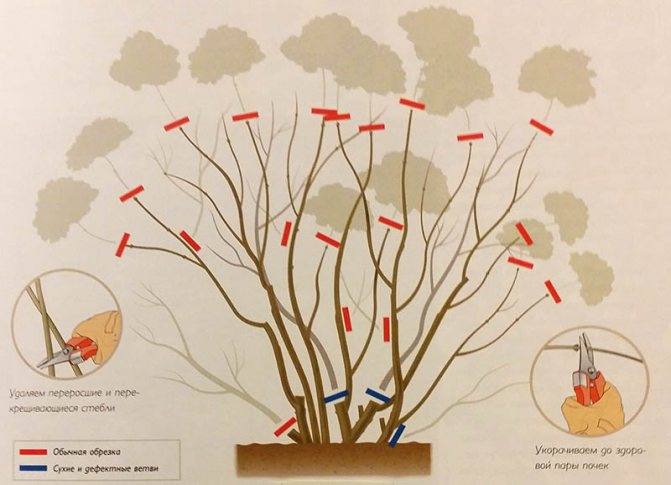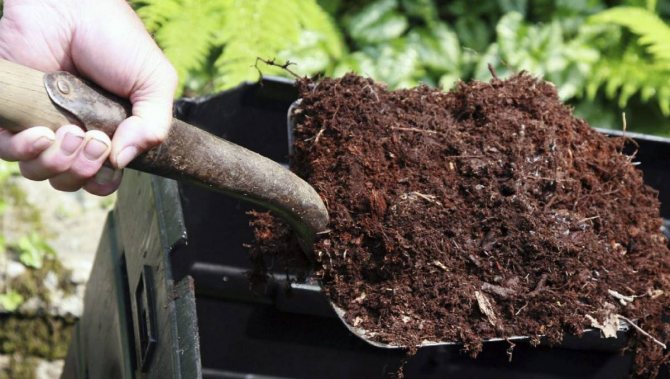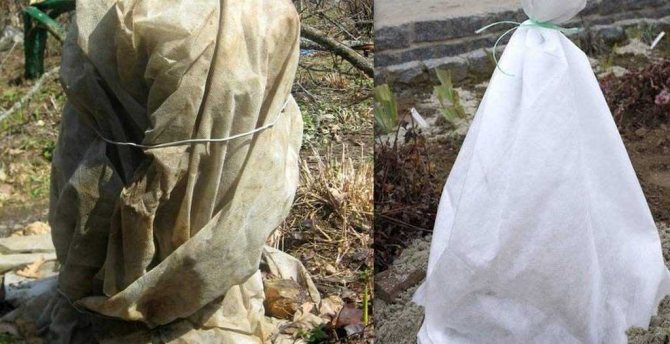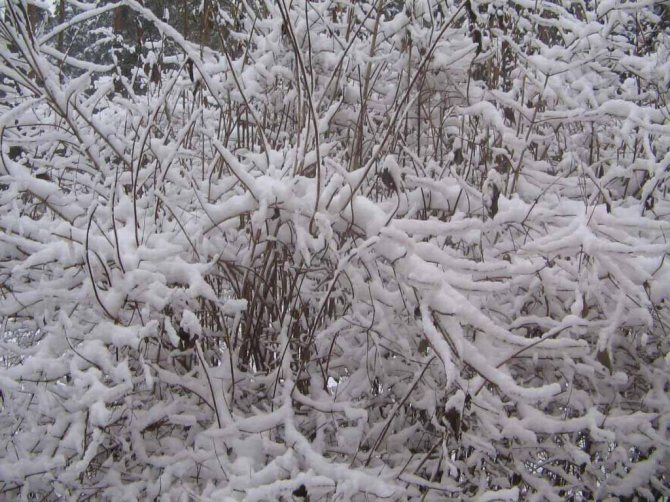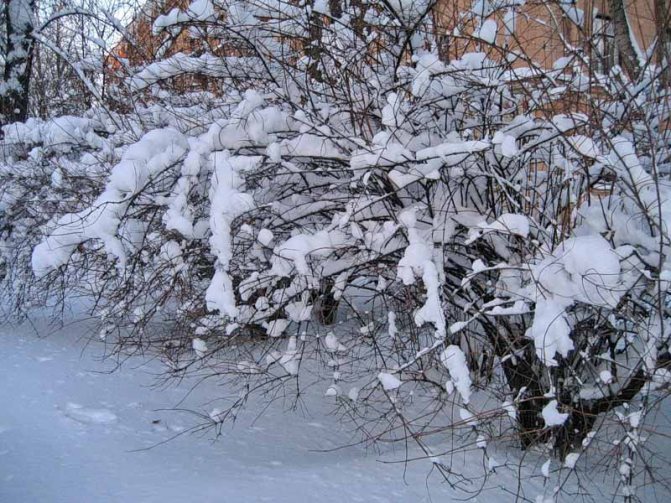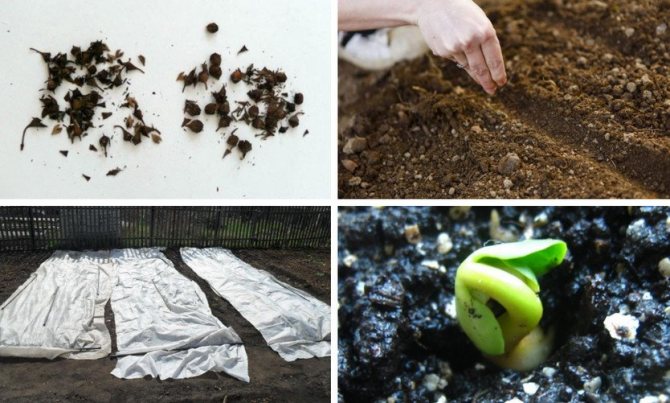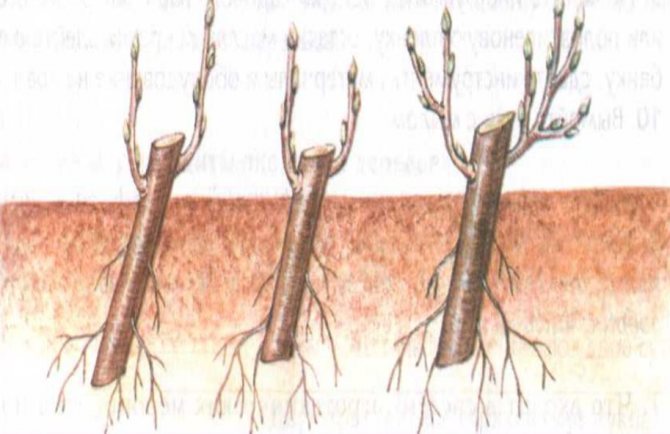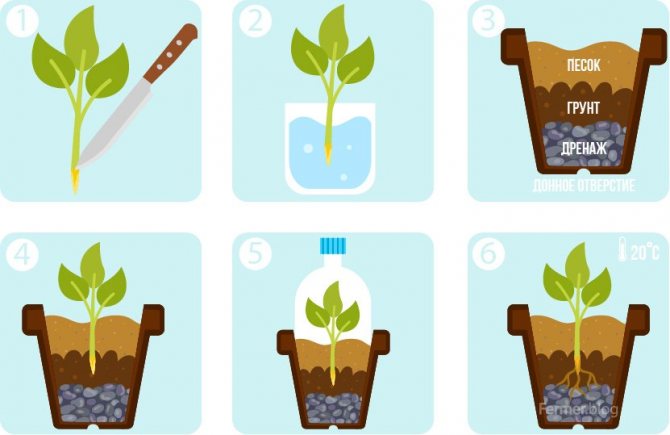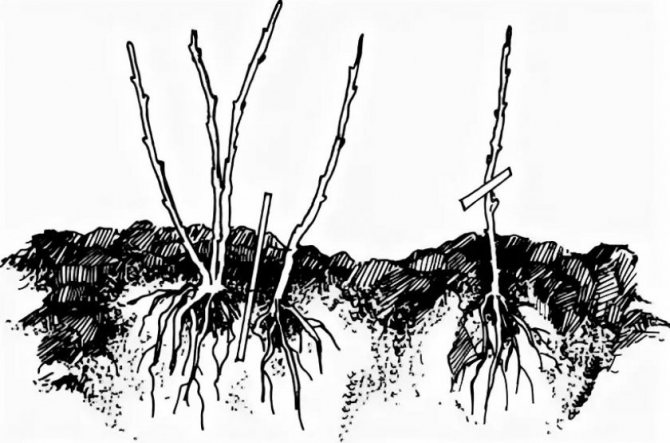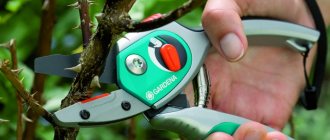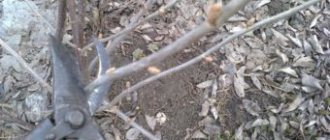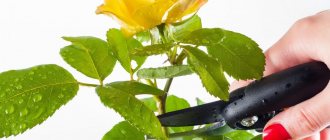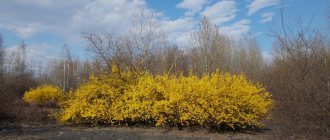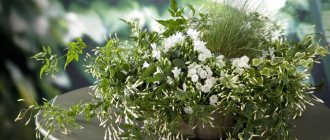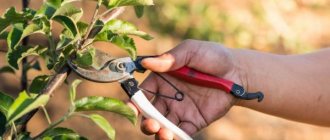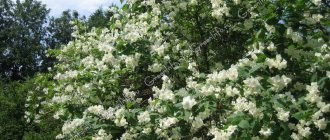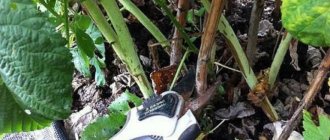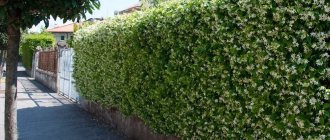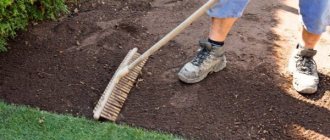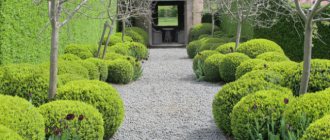When growing ornamental shrubs, a novice gardener may find it difficult to prune jasmine. In autumn or spring, to carry out this work, at what age to start, what shape to give the plant - these and many other questions sometimes do not find an answer. Don't worry, this is an unpretentious plant, caring for it is simple. The first time may turn out to be unsuccessful, the shape of the bush will be uneven, but do not give up. Take into account the mistakes and repeat the procedure after six months. Each time you will gain experience, and after a while you will be able to compete with a professional landscape designer.
Description and features of culture
Jasmine is a name for two different kinds of plants. The real one is an indoor culture belonging to the olive family. The bushes growing in the garden are also called jasmine for the similar scent of flowers. In fact, this is a chubushnik plant belonging to the Stonefragment family.
Jasmine is a sprawling, multi-stemmed shrub. Flowering lasts from late May to mid-summer, depending on the variety. Chubushnik is decorative during the entire growing season. The flowers are large, in some varieties they reach a diameter of 6 cm.
With free growth, the branches reach a length of 2 m. They are curved and look very sloppy. Because of them, the chubushnik does not have enough strength to properly nourish new shoots. In order for him to constantly delight the gardener with beautiful flowers, he needs to be cut regularly.
When to harvest jasmine
Many people know that jasmine flowers can not only please with their appearance and aroma in spring and summer. Gardeners also collect it for the preparation of aromatic oils and tea. This can be done on any day of the flowering period, but you need to know one feature of this plant.
Important! If the flowers are planned to be used in the near future, then any of them will be suitable for collection. But for long-term storage, it is recommended to pluck only the buds.
Jasmine flowers tend to bloom not with sunrise, as is usually the case, but with the onset of night, and therefore it is better to harvest raw materials in the early morning, before sunrise, at the time of mass opening. It is at this time that all useful substances are collected in jasmine and in a large concentration.
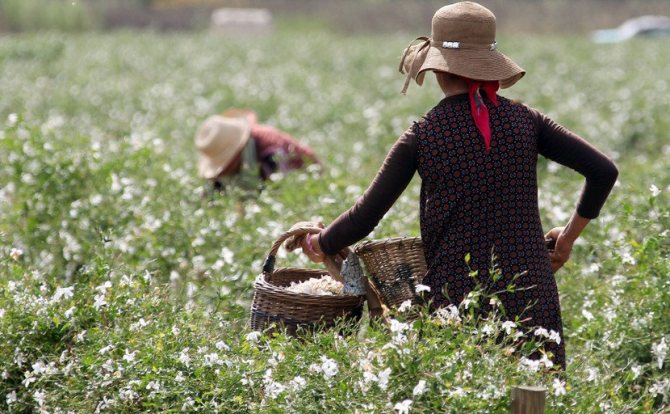
Pruning a plant: basic rules
Pruning is an important step in caring for a chubushnik. There are several types of procedures.
- Shaping - allows you to change the crown, make it symmetrical, round, pyramidal, etc. Promotes good growth of new shoots and flowers.
- Sanitary - the main task is to improve the health of the plant. Broken, dry, old, diseased branches and shoots are subject to unconditional removal. It is better to carry out at the end of winter before the beginning of active sap flow.
- Rejuvenating - renewal of the crown by removing all old and diseased branches.
On a note.
The first time the shoots are shortened immediately after planting, leaving 2-3 pairs of buds at the base. Because of this, flowering will be postponed for a year, but many powerful shoots will appear. In the future, it will be easier to form a crown from them.
Jasmine pruning
What to do next when the jasmine has faded
During the growing season, new branches are formed, some of which damage diseases and pests.They also need to be removed, so around August the mock-orange is cut.
How to properly prune jasmine after flowering:
- thin out the bush;
- shorten long shoots to correct the shape;
- remove wilted inflorescences;
- remove diseased and dry branches.
This procedure improves decorative qualities, sets the desired growth direction and performs a sanitary function.
Pruning rules
For the procedure to be successful and beneficial, you need to know how to prune jasmine:
- shoots that form at the base of the bush worsen its decorative qualities and are completely removed;
- roots that appear on the soil surface are immediately cut off;
- during molding, the optimal plant height (1.5-2 m) is maintained so that the crown is evenly illuminated;
- it is forbidden to cut off strong branches too short, and leave weak ones long;
- you cannot remove the apical part of two-year-old branches, because a crown is formed from them.
Small sections do not need to be processed. Large ones must be covered with garden var.
Pruning rules
Why does jasmine need pruning?
When approaching many summer cottages, you can feel a strong but pleasant aroma. It is emitted by a lush bush covered with white flowers - garden jasmine. An ornamental plant gives charm to a flower garden, looks great in hedges, and it becomes incomprehensible why such a beautiful flower was given a dissonant name - chubushnik. Perhaps this word escaped from a person harvesting wood for pipe shanks, at the sight of wild gnarled bushes with old cracked branches, with a too dense but uneven crown and stunted inflorescences.
Jasmine is unpretentious, it can grow without any care, but its decorative qualities are reduced. Old trunks do not allow new shoots to develop correctly, frozen and broken branches serve as a haven for pests and a breeding ground for infections. Poorly developed young growth will not be able to produce many buds, flowering will be weak. Uneven branches will not add charm to either a flower garden or a front garden, and strongly overgrown plants planted close to each other will resemble an impenetrable jungle.
If the jasmine is allowed to grow freely, some shoots can overcome a height of 2 m. Long branches sticking out in different directions look sloppy. Such bushes are not suitable for either landscape design or hedges. Old trunks do not bloom, but they take away light and nutrients from young shoots. Instead of lush white hats, rare small flowers will appear on the bushes. Anyone who walks past such thickets will get the impression that the site is abandoned and the owners are not doing it at all.
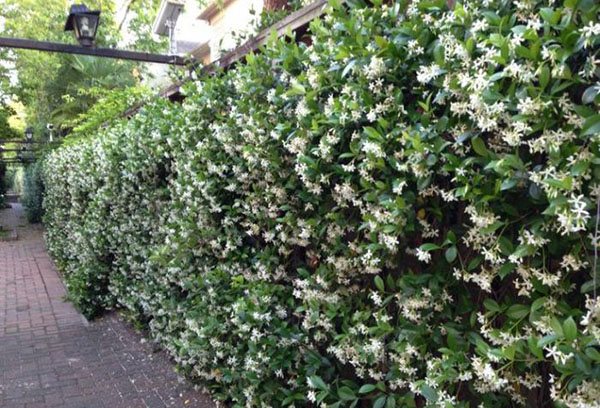

When and how to trim jasmine
Chubushnik accepts pruning well, so it can be done throughout the season. However, it is more correct to do this at a certain time.
How and when to prune jasmine:
- in the spring - remove frost-damaged and broken parts;
- after flowering - when pruning jasmine, broken branches and wilted, but not fallen inflorescences are removed, bushes are thinned;
- in the fall - the mock-orange is prepared for wintering by cutting off old branches.
Important!
Thanks to the autumn procedure, the plant spends less energy on food and tolerates cold better.
Flowering bushes are thinned out every year, because over time, many basal shoots and twigs appear. Chubushnik thickens strongly, flowers and leaves become small. All weak basal shoots are cut to the ground.
The end of winter is the best time for rejuvenation. Over time, the number of leaves decreases, the branches look bare and unattractive. These are sure signs of aging.
While the kidneys are not yet swollen:
- cut off old branches;
- remove damaged shoots;
- form a crown.
When and how to trim jasmine
Chubushnik has a powerful root system that is able to provide food for many new branches. Therefore, the old crown is safely removed, stimulating the growth of shoots.
Important!
After spring pruning, jasmine bushes are fed every 10 days with phosphorus-potassium fertilizers. At the same time, they are watered abundantly, and the soil is mulched in the near-trunk circle.
Preliminary activities
Caring for jasmine in the fall begins with examining the shrub for traces of various diseases and the presence of parasitic individuals. If signs of diseases and harmful insects are detected, the garden plot should be treated with a special microbiological preparation "Fitosporin-M".
Jasmine, which is popularly called mock-orange, belongs to moisture-loving ornamental crops, but excess moisture in the soil can lead to rotting of the root system. For this reason, the need for water charging irrigation on the eve of the winter cold snap must be determined by the weather. If the autumn turned out to be damp and generous in precipitation, the soil under the spreading shrubs need not be moistened.
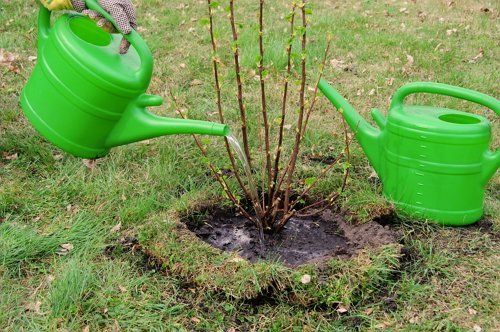

Removing weeds and loosening the soil contributes to the enrichment of the root system of the chubushnik with oxygen. At the end of summer or in the first days of autumn, you need to feed the shrub with phosphorus-potassium fertilizers. Nitrogen-containing preparations are used in spring and summer, as they stimulate abundant growth of vegetative mass. The young shoots that have appeared will not withstand even the smallest frosts.
One of the stages of preparing garden jasmine for wintering is rejuvenating crown pruning, which supports the decorative effect of the shrub. According to the recommendations of experienced gardeners, all old shoots injured by insects, rodents and diseases should be removed. It is also recommended to prune branches that are 4 years old and older. In the absence of anti-aging pruning, the ornamental shrub quickly loses its endurance and winter hardiness.
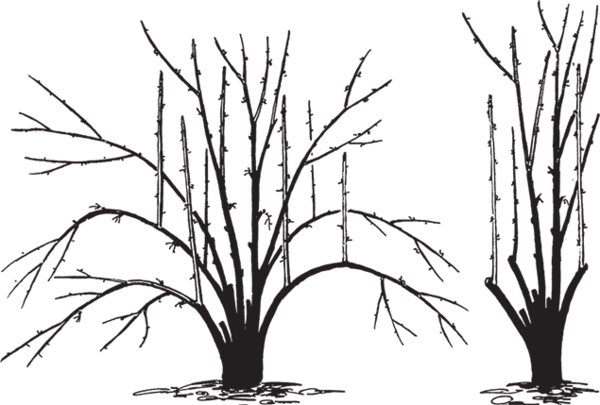

Video: "Autumn cropping"
After watching this video, you will know how to properly prepare jasmine for winter.
Pruning in the fall: basic rules
Before the procedure, it is important to prepare suitable cutting tools:
- hacksaw;
- secateurs;
- lopper.
They must be sharply sharpened. Dull inventory cannot be used. It damages young branches. Fresh cuts are immediately covered with garden varnish so that frostbite or fungal infection does not occur.
The procedure is carried out until the temperature has dropped below -10 ° C. In frost, the bark becomes fragile. Because of this, there is a great risk of damaging healthy shoots.
Cropping is done as follows:
- Trunks over five years old are cut down.
- Remove sick, growing inside the crown or at the wrong angle of the branch.
- Give the crown the desired shape.
In order for new branches to grow actively, the chubushnik needs increased nutrition. Top dressing is carried out before cutting.
On a note.
Autumn is the best time to harvest cuttings.
Pruning in the fall
The crown can be formed throughout the season if:
- jasmine is too thick;
- stretches in height;
- grows asymmetrically.
These factors negatively affect flowering and inhibit the development of culture.
How to correctly form a jasmine bush:
- To delay the pulling of fast-growing branches, their number is halved. Due to this, lateral processes appear, on which new inflorescences are formed.
- To reduce the density, up to 4 old shoots and branches growing inside the crown are completely removed.
- To give the bush the correct shape, they practice pruning large and elongated shoots.
On a note!
Most newbies don't know how best to trim jasmine to make it look pretty. Beginners can simply make the bush symmetrical. The more experienced ones form a ball, cube or other geometric figure out of it.If the plant develops normally and does not lose its decorative effect, then such pruning is carried out every 4 years.
When is the best time to prune jasmine?
Jasmine easily tolerates pruning, so you can shorten shoots that violate the shape of a bush or hedge throughout the summer season. In the spring, you need to inspect the bush, check what damage was left by the winter cold.
Until the buds are swollen, spring pruning should be done, which includes:
- cutting down old branches;
- removal of frozen and broken shoots;
- crown formation;
- rejuvenating the bush.
Over the summer, jasmine will grow, some branches will be damaged by diseases and insects. You cannot leave the plant in this form for the winter. In the fall, you need to prepare the bush for wintering and spring development. To keep ornamental shrubs always looking neat, they need to be pruned annually in spring and autumn.
After flowering, a number of procedures should be performed:
- remove wilted inflorescences;
- thin out the bush by removing old trunks;
- remove damaged and diseased fragments.
In the fall, you need to not only cut off, but also feed the jasmine for the winter. Plan this work in advance, since fertilization can be applied either before pruning, or 2 weeks after the procedure. Do not delay removing old branches - the work must be done before the temperature drops below -10⁰ C. The wood of the plant is fragile, removing frozen fragments, you can injure young shoots.
The very first pruning should be done immediately after planting, no matter when it happens: in spring or autumn. Immediately think about what shape you want to give the jasmine, determine which shoots are growing in the wrong direction, and remove them. Leave no more than 3 trunks on which the strongest buds are located. Cut off the rest mercilessly - the bush will gain splendor over time, and the newly appeared shoots in the open space will begin to actively develop and the next year they will be covered with flowers.
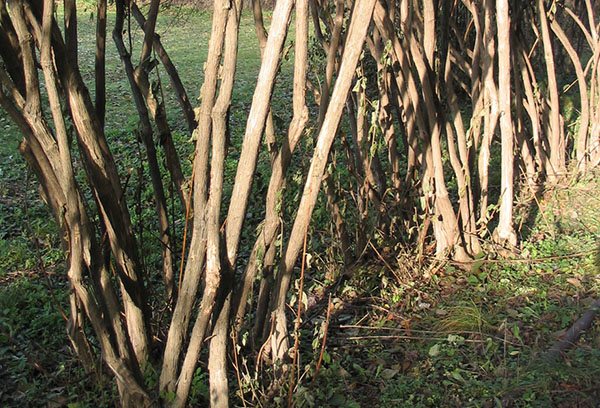

The best varieties for landscape design
More than 70 varieties of chubushnik have been bred. In ornamental gardening, the most popular are:
- Avalanche - up to 1.5 m high, with arched curved shoots. Flowers are white, fragrant. Oval petals.
- Sibylla is a plant with a dense spreading crown up to 1 m high. The flowers are white, with a delicate pink tint at the base. The stamens are bright golden in color.
- The ermine mantle is a compact (0.6-0.8 m) shrub with falling branches. Flowers are white, semi-double, smell of strawberries.
- Moonlight - about 70 cm high. Shoots are thin, reddish. The flowers are terry, greenish-creamy with a strawberry scent.
- Zoya Kosmodemyanskaya is a lush bush about 1 m high. The flowers are large, up to 5 cm in diameter, white, double, with a slight aroma.
Timely pruning of jasmine can restore its former beauty to a stunted bush. This is a mandatory procedure that revitalizes and rejuvenates plants. If you properly care for the mock-orange, it will bloom actively and profusely.
Garden jasmine (chubushnik) is very popular among gardeners due to its high decorative qualities, especially during the flowering period. And the aroma of its flowers - strong enough, sweetish and pleasant - is familiar to many from childhood.
This article will tell you how to care for your garden jasmine in the fall and prepare it for winter. Its active flowering in the next season depends on the correct implementation of these procedures. But if novice flower growers carry out these procedures incorrectly or not in full, then the mock-orange may weaken, it is worse to endure the winter period, and in the next season it is worse to grow and bloom.
How to rejuvenate old bushes?
When you notice that the foliage is no longer growing so luxuriantly, the branches look naked and unattractive, you need to understand that the bush is old. It is not necessary to uproot jasmine and plant new cuttings; it is in your power to rejuvenate it.Perennials have a strong root system, and if they are healthy and working well, young shoots will grow vigorously. You only need to give an incentive for the emergence and development of new branches, and for this, first of all, you should remove the old crown.
When cutting branches and trunks, it is better to cut at an angle of 45⁰, then the wounds absorb less water, which causes rotting and serves as a source of reproduction of harmful microorganisms. After pruning, be sure to treat the wounds with garden varnish.
The best time for rejuvenating pruning is spring, before the buds begin to swell. If you are late with this work, you can do it in the summer, just not during the flowering period. But it is better to postpone it to autumn. Choose 4-5 of the strongest and youngest shoots, cut them at a height of 0.5 m from the ground. Cut the rest of the trunks to the ground. In the spring, the bush will release young branches, which will be covered with green leaves. In April or May, when new shoots appear, remove them, leaving no more than 3 branches on each trunk. In a couple of years, a lush young jasmine will bloom under your window.
After pruning garden jasmine, treat all wounds with garden varnish. The plant needs good nutrition to recuperate after surgery. But if you didn't feed the bushes before the procedure, now is not the time to do it. Let the plant grow strong for a couple of weeks, and then feed it with manure or compost. After the spring procedure, the bush needs to quickly gain strength. Feed it every 10 days, water it well, mulch the soil under the crown.
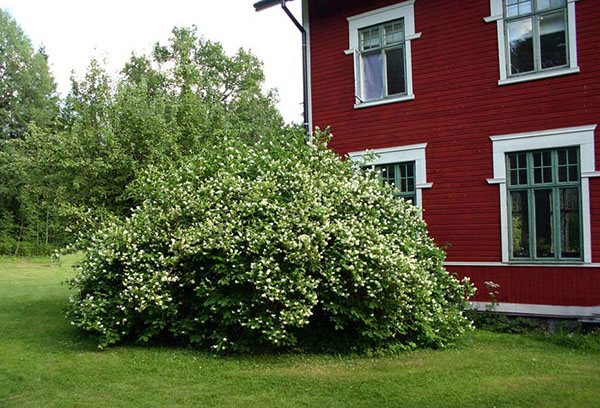

If you have an unsightly unkempt mock-orange bush growing on your plot, pruning will turn it into a beautiful garden jasmine. In the fall, the gardener has a lot to do: you need to harvest and process the crop, prepare the beds for the new season, and shelter delicate plants from the cold. Take time to feed and prune your ornamental shrub. In the spring, green leaves will bloom on it, and in the summer the entire crown will be covered with beautiful fragrant white flowers.
Pruning jasmine in autumn
One of the main activities associated with caring for this perennial is pruning the chubushnik bushes.
Various types of pruning of these shrubs are carried out:
- formative;
- anti-aging;
- sanitary.
Some of these events are carried out in the spring, some in the summer, but jasmine should be cut off in the fall as well. How to do this correctly will be described below.
Why prune jasmine
Usually formative pruning is carried out in the spring
before the kidneys begin to swell. Large shoots are cut into several buds, weak ones are shortened by ½ the length. After that, during the spring-summer period, young twigs will actively grow in jasmine. At the same time, the frozen parts of the shoots are removed.
With age, the perennial "grows old", old branches begin to bare, thereby drowning out young shoots. The decorativeness of the chubushnik is also lost. Therefore, rejuvenating pruning should be done every 7-9 years.
In spring, usually the strongest and most powerful shoots are shortened to 50 cm in height (usually no more than 5), and all others are cut to ground level. Places of cuts are treated with garden varnish in order to prevent the entry of pathogens. The soil surface is usually mulched with well-rotted compost, and the soil itself is watered with a solution of cow dung.
Video: all about chubushnik (jasmine)
When is it best to prune jasmine - fall or spring
Chubushnik pruning is carried out in spring and autumn. In spring, formative and sanitary pruning is usually carried out. In this case, the bush is given the necessary shape, excess branches, frozen, dried or broken off shoots are removed. In autumn
but basically all the young shoots of the chubushnik that have grown too much during the season are pruned or carried out
rejuvenation of the shrub.
And during the summer season
you should cut off the shoots growing inside the bushes and thicken them, damaged or broken branches, and also remove the fading buds.
How to prune jasmine in the fall
Jasmine grows well over the season, so it is imperative to cut it in autumn to maintain the decorative shape of the bush. Otherwise, old shoots will not allow new shoots to grow, and they also take on too many nutrients.
This procedure is best carried out in the fall, when the shrub has faded, the growth and lignification of young shoots has practically stopped, and the perennials themselves are preparing for winter "hibernation". But such a procedure should be carried out at an air temperature not lower than -2 ..- 4 C. In this case, the wood of the shoots does not freeze yet and will not be injured.
To carry out such work need special tools
, which must be sharp so as not to injure the wood of the branches. These tools include: pruner, lopper, feast, hacksaw, as well as special putties, which are necessary for processing the cut points so that pathogens do not get there.
Autumn pruning of jasmine is necessary to achieve the following goals:
- reducing the thickening of perennial shrubs;
- for their rejuvenation.
All other types of pruning are carried out in the spring.
As a result, in the fall, all young shoots that grow inside the bush, old, dried or damaged branches are removed. Deformed or curved parts of the shoots should also be removed.
Rejuvenating pruning in the fall relieves the chubushnik from old branches, which only interfere with the normal development of the bushes, and also promotes the growth of a new crown. In the next season, such bushes after pruning will begin to bloom more actively.
If you neglect this procedure, then after two or three seasons, jasmine may stop blooming altogether.
Video: pruning garden jasmine (mock orange) in the fall
Care before and after pruning
Autumn work on the care of the chubushnik should include the last dressing and autumn watering.
Although garden jasmine (chubushnik) loves moisture very much, by autumn (after flowering ends) the amount of watering is usually reduced so that the plant does not begin to build up its vegetative mass again. The last watering should be carried out a couple of weeks before the onset of frost. If the end of summer and autumn are rainy, you can stop watering the jasmine yourself altogether.
The last jasmine dressing
spend in late summer - early autumn. It allows the plant to recuperate after active growth of shoots and abundant flowering. These flowering bushes need nutrients to prepare for winter. Moreover, they should be introduced several weeks before frost, while the flow of sap has not yet stopped in the shoots, because it is with the juice that useful substances enter the upper part of the plants. The composition of the last feeding includes potassium and phosphorus - those mineral elements that are necessary for a mock orange in the autumn. But the main part of nutrients accumulates in the root system, which does not "fall asleep" even in winter.
Usually the last time fertilizers
applied under jasmine one and a half to two weeks before autumn pruning or two weeks after it. But with the onset of cold weather, top dressing is not worth it - the chubushnik will not have time to process them, and during the winter and the beginning of spring all the nutrients in the soil will decompose, and there will be no sense from their introduction.
Necessarily needed remove all fallen leaves
around the chubushnik so that pests or pathogenic microorganisms do not remain in it for the winter. It is better to burn all foliage, as well as cut branches, immediately.
After autumn pruning jasmine can be sprayed with 2% copper sulfate solution or 1% Bordeaux liquid
... This treatment is preventive.
We form the crown
The formative pruning of the chubushnik should be carried out throughout the season, including in the fall. To prevent weak shoots from thickening the crown and taking away light from strong branches, thin branches are shortened by half or completely removed.If the plant does not waste nutrients to develop useless fragments, it will release many new shoots in the spring. In the first season, they will only have dense green foliage, but the next year, lush flower caps will bloom.
If you are using shrubbery to create green fences, a good formative jasmine pruning is essential. Curbs along paths, flower screens around benches, mazes of bushes should be even and thick. Remove thin twigs, and shorten the strong shoots slightly - they will give a lot of foliage, and the hedge will be lush. Shoots grow quickly, and after a while, instead of a clear surface, you will see branches sticking out in different directions, giving the plantings an unkempt look.
The top of the green fence does not have to be flat. You can make waves, turrets, ledges - it all depends on the design style of the suburban area. On a flower bed, a bush can be shaped like a ball or a cube; on the playground, kids will be pleased with figures of animals or toys.
Advice
For the first time, you can invite a specialist for a decorative haircut, then you will trim the bushes according to his model.
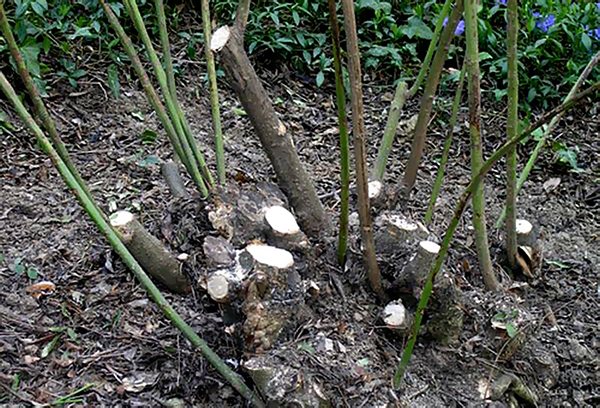

Jasmine shelter for the winter
The shelter of jasmine for the winter is not carried out in the warm regions of our country, since the winters are warm there, and the chubushnik is a fairly frost-resistant shrub. But the need to carry out this procedure in colder areas should be reminded to novice gardeners. Although it is believed that this flowering perennial has a high resistance to frost, its root system is quite thermophilic. Therefore, it must be protected from possible severe soil freezing during severe winters in some regions of Russia.
There are jasmine varieties that are resistant to extreme cold. And the only thing that can happen to them is freezing of annual twigs. But instead of frozen shoots, new strong shoots will grow during the season, and the crown of these flowering bushes will not suffer.
How to properly cover jasmine for the winter
Adult jasmine bushes do not need shelter for the winter. Saplings planted during the season or those chubushnik bushes, whose age does not exceed 3-4 years, should be snatched. Usually they are covered with any special material and tied with twine.
The soil in the near-trunk circles of this plant should be dug up, while all weeds should be removed. And on top, a layer of mulch with a height of about 15-20 cm should be poured. Such a shelter will protect the roots of shrubs from the impending cold weather. As a mulching material, you can take dry needles, rotted compost or manure (but not fresh!).
Chubushnik protection from winter frost
Shelter for the winter of this plant is quite easy to make. Most of the jasmine varieties that are cultivated in our latitudes are well adapted to winter. However, special attention should be paid:
- for varieties with low winter hardiness;
- young shrubs of any kind;
- tender young shoots that began to grow in the past summer.
It is these categories of chubushnik and parts of the bush that are most at risk during short-term severe frosts or temperature drops in winter.
Preparing jasmine for the winter, regardless of the age and size of the bush, has 2 tasks:
- First of all, you need to cover young shoots in order to protect them from frost.
- Finally, you need to take care that young branches do not break from the weight of the snow, which can melt and freeze again, and become compacted due to temperature changes. In this case, if the shoots are not protected, they can break, and then in the spring the bush will grow unevenly.
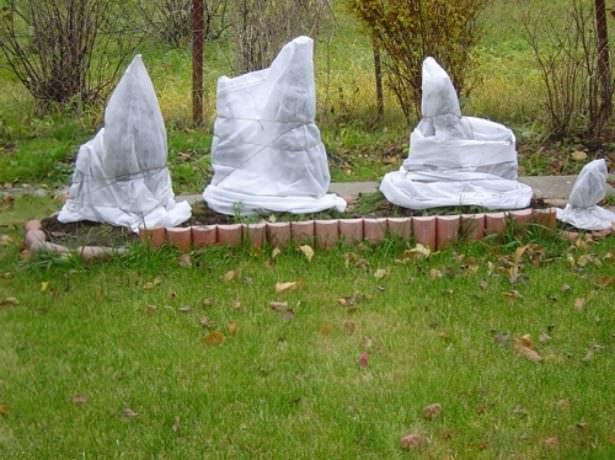

Standard technology:
- The branches are pressed to the ground and pinned.
- The whole bush is wrapped in spundbond.
- Several heavy stones are laid on a sheet of material so that it will not be blown away by winter winds.
In the spring, a few branches or their tips will die off anyway.Therefore, the first step is to carefully examine the entire plant and cut off all branches that are clearly damaged by frost, otherwise the jasmine will grow rather poorly and will not give an abundance of flowers.
What are the features of preparing jasmine for the winter in different regions
In principle, autumn care for a mock-orange is practically the same in different regions of our country. But there are still some nuances.
In the middle lane
In the middle lane (in the suburbs), this shrub is usually planted in sunny places, but so that they are protected by a fence or garden structures from cold winter winds - then jasmine will not freeze in winter from gusts of strong cold winds.
In the Volga region
In the Volga region, autumn care for jasmine does not require much effort - usually all the same agrotechnical measures described above are carried out.
In the Urals and Siberia
In the Urals and Siberia, where winters are usually quite harsh, and the ground can freeze to a depth of 1 meter (or more), the jasmine trunk circle should be well covered so that its root system does not suffer during severe frosts, especially young roots that have grown for the season. Therefore, in these regions the layer of mulch should be thicker - up to 25-30 cm. And an additional "cover" for the roots in these regions is usually snow, which most often falls in a fairly thick layer and does not melt all winter.
Features of planting chubushnik in autumn
This perennial shrub can be planted outdoors in both spring and fall. Seedlings can be purchased in specialized stores - usually there they are sold with a closed root system. A chubushnik with an open root system is usually taken either from neighbors in the garden, or propagated independently (most often by cuttings). The root system holds the earthen ball well during transplantation, it tolerates acclimatization in a new place, and quickly takes root in new conditions.
- The area where this perennial ornamental shrub will grow should be well lit, without stagnation of moisture in the soil.
- In the planting holes, a layer of drainage material should be placed on the bottom, consisting of crushed stone with river sand (its height is 12-15 cm), and then a layer of soil mixture. It is composed as follows: 3 parts of leafy earth, 2 parts of humus and one part of sand are mixed.
- In group plantings, the distance between jasmine bushes should be at least 0.6 to 1.4 m, and when planting these perennials in a single-row hedge, the distance between seedlings should be 0.7-0.8 m.
- The planting depth of young bushes should be no more than 0.5-0.6 m, and the root collar should be at the ground level, when it is buried in the soil, it rots.
Common mistakes in caring for jasmine in autumn and preparing for winter
Jasmine is an unpretentious garden plant that does not require special care. But there are a number of procedures that need to be carried out in the fall. But sometimes beginners can forget about the following activities:
- about the introduction of autumn feeding;
- cut the chubushnik bushes incorrectly, without removing all old branches or leaving shoots that grow inside the bushes;
- begin to insulate the aboveground part of the plants too much, as a result, if warming occurs, the shoots may flutter.
One of the most important shrub care items is plant pruning, which has a positive effect on health, growth, flowering quality and longevity. Gradually expanding, the shrubs acquire a sloppy appearance, become too thick, old branches inhibit the growth of young shoots, which significantly reduces the life of the plant. Both fruit and ornamental shrubs need pruning. However, you need to know when and how to prune certain shrubs, because incorrect or untimely pruning can lead to disease and even death of plants. About what shrubs are cut in the fall, how and when exactly it is necessary to do this, and there will be a conversation.
Bush care before and after pruning
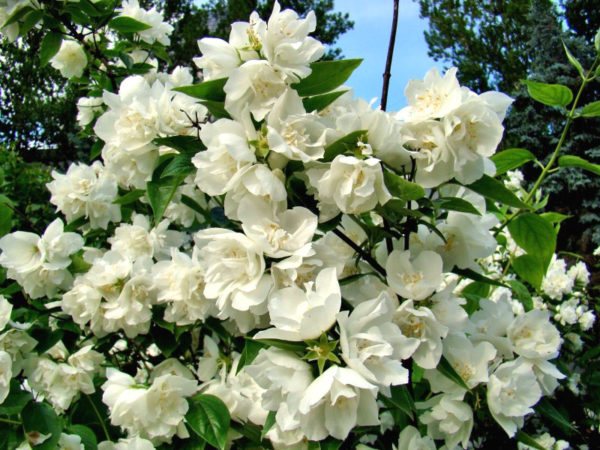

After the procedure, any plant needs careful care. Despite the fact that jasmine tolerates pruning well, it is no exception. First, you need to control the moisture content of the soil, it should not dry out. If the jasmine is watered outside warmly once a week. During periods of drought and high air temperatures, watering is carried out twice a week. In addition to using mineral fertilizers, mullein or rotted manure is introduced into the soil two, three times during the summer. This will provide the bush with nutrients and will increase the number and quality of buds in the future.
In autumn, if it often rains, then watering is completely stopped, if the weather is dry, then the last time before winter I water it 14 days before the first frost. Watering will need from 10 to 20 liters of water, the amount depends on the age of the plant. Also, before winter, mineral dressings are introduced, potassium and phosphorus are considered the most necessary substances for a mock orange during this period.
After pruning near the jasmine, all fallen leaves and cut branches are removed, because pathogens and parasites can hibernate in them. After harvesting, the bush is sprayed with copper-containing preparations for prophylaxis.
Pruning ornamental bushes
Autumn is the best time to prune shrubs, because at the end of the growing season you are not pressed for time, as is usually the case at the beginning, when the time interval between the onset of spring and the beginning of sap flow in plants is too short, during which it is too late to prune. The only precaution that must be observed when pruning shrubs in the fall is not to carry out the procedure at temperatures below -10 ºC, so as not to injure wood that is too fragile from frost.
Here is a rough list of the tools you may need to do the trimming:
- sharpened pruner with two blades. Ideally, the blades of this tool should be of such length that, when fully diluted, a branch with a thickness of one and a half to two centimeters is placed between them. It is a good idea if the tool is equipped with such improvements as a serrated amplifier, a rotating handle and ratchets with which you can cut old thick branches in three steps;
- lopper - a type of pruner with long arms, which is used to trim large branches in hard-to-reach areas of the dense crown. The lopper is also much more convenient for pruning thorny shrubs and cutting below soil level. The more the blades taper towards the ends, the more versatile the tool is;
- saws and hacksaws for removing large branches;
- putty to protect the sections from infection and drying out. You can use garden var or modern factory-made preparations containing physiologically active and disinfecting substances that contribute to the rapid healing of wounds.
There are two types of pruning of flower shrubs: pruning and thinning. Shortening the shoots helps create the shape of the bush, regulates flowering and limits over-growth, while thinning is the sanitary or rejuvenating pruning necessary to prolong the life of the bush. In most cases, autumn pruning of shrubs serves sanitary purposes, and if the plant has reached old age, pruning of branches is carried out in order to rejuvenate it. True, there are shrubs that are better formed in the fall, and not in the spring.
Basic rules for autumn pruning
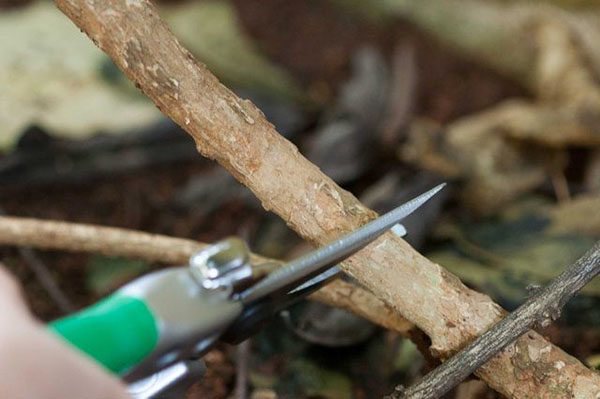

For the first time, jasmine is pruned immediately after planting; experienced gardeners recommend leaving only 3-4 of the strongest trunks. Do not feel sorry for the young growth, in a year it will grow twice as powerful, and the jasmine will decorate the garden plot with its appearance.
For the pruning procedure, you need to prepare sharpened, sterile garden tools. Young shoots and thin branches can be pruned with a pruner or a delimber. But for removing old and powerful branches, they will not work; a hacksaw is used for them.First, with the help of a pruner, the inflorescences that did not fall off are removed, then the branches that are dry or damaged and have traces of disease. After thickening shoots. And at the end, you can give the bush the desired shape. The procedure is carried out very carefully, when cutting down old branches, you cannot damage the young growth, because it is she who will give abundant flowering next year. Places of cuts are treated with garden varnish or other antiseptic, this will save the bush from infection and pathogenic microorganisms.
Inexperienced gardeners first need to learn how to cut jasmine exactly, and after a few years you can give the bush any shape. Also, cuttings are often harvested in the fall, and in the next season they are planted. To do this, young shoots are cut along with a piece of the trunk and cut into cuttings. Their length should be approximately 5 cm, also a pair of internodes and a small amount of foliage should be located on one cutting. The cut under the internodes should be at an angle of 90 degrees, cut horizontally above the kidney. Planting material is stored until spring in a dry room at a temperature of 0 0 Celsius.
Pruning roses
When to prune roses
Thinning autumn pruning of rose bushes is carried out in order to ensure access of light and air to the middle of the bush, so that all buds and stems are supplied with them in sufficient quantity. In addition, pruning branches that have given flowers for more than one year stimulates the laying of new buds and the formation of new, stronger branches. Pruning is done in October, towards the end of the month, and if the autumn is long and warm, then pruning in November is also quite acceptable.
Pruning roses in autumn
Pruning roses after flowering is not particularly difficult. Not only adult roses are cut, but also those planted this year. All diseased, dry and weak shoots, buds and flowers are removed from the bushes, leaving no more than five strong, developed young branches growing approximately equidistant from each other on the rose bush - the bush should look, if not symmetrical, then harmonious. Do not leave young shoots on the bushes that will not have time to ripen before the cold weather, because under cover they can rot, infecting the entire bush with a fungal disease. The remaining shoots are shortened by 20-30 cm. Hybrid tea, polyanthus and floribunda roses are cut short, leaving only four well-developed buds on each stem. Shoots of remontant roses and grandiflora roses are cut in half, leaving no more than five developed buds on them. Shoots on Old English and Shrub roses are cut to three-quarters or two-thirds of their length. In climbing roses with small flowers, the ends of the shoots are only slightly cut off, and in those with large flowers, the shoots are shortened by a third. Plant residues after pruning are best burned.
Mode of autumn watering chubushnik
Almost all varieties of chubushnik, of which more than 70 are known, love quite abundant watering. Moreover, if in the summer you always need more water, then in the fall the amount of moisture is gradually reduced - every week from mid-August until the onset of frost.
As a result, the last portions for watering (at the end of September) should be one third or half less than the usual summer ones. Moreover, if during the summer, watering is combined with fertilization (for example, manure with water), then in the second half of September you just need to add water so that the soil remains slightly wet, and stop feeding after the first decade of autumn.
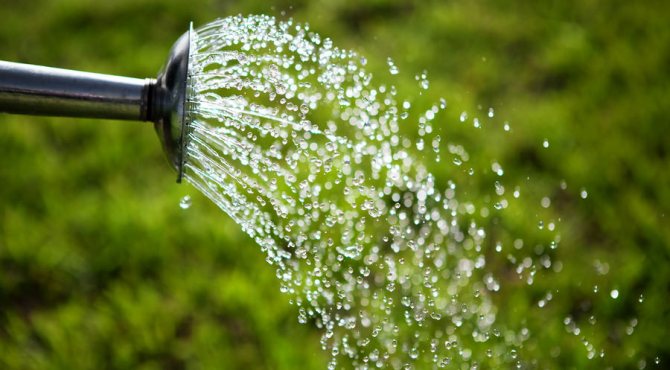

Pruning clematis
When to prune clematis
Sanitary pruning - the release of clematis from broken and dried shoots - is carried out throughout the growing season. But pruning in November, and it is at this time that professionals recommend pruning clematis, is an important and complex agronomic measure: the fact is that there are three groups of pruning clematis, and each of them has its own pruning method.
Pruning clematis in the fall
We offer you a classification of clematis in terms of the method of autumn plant pruning:
- the first pruning group (No. 1 or A): it includes clematis of the Florida groups (for example, flowering clematis) and Patens (for example, spreading clematis), which bloom only on the shoots of the second year, therefore, all non-lignified and weak shoots are removed for the winter, the rest shorten by a third so that the length of the shoot does not exceed one and a half meters;
- the second pruning group (No. 2 or B) includes woolly clematis, several varieties of the Patens and Florida groups, and varieties of the Lanuginoza group. These clematis bloom in the spring on overwintered shoots, and by the end of summer, young shoots also enter the flowering process. In these clematis, the bush is cut to a height of 50-100 cm from the surface of the site, but if the bush needs rejuvenation, then you can cut it down to the first true leaf;
- the third pruning group (No. 3 or C) includes all clematis of the Viticella and Zhakman groups, blooming only on the shoots of the current year. These clematis are cut off entirely, leaving only shoots with 2-3 nodes.
In what period is it better to prune a chubushnik
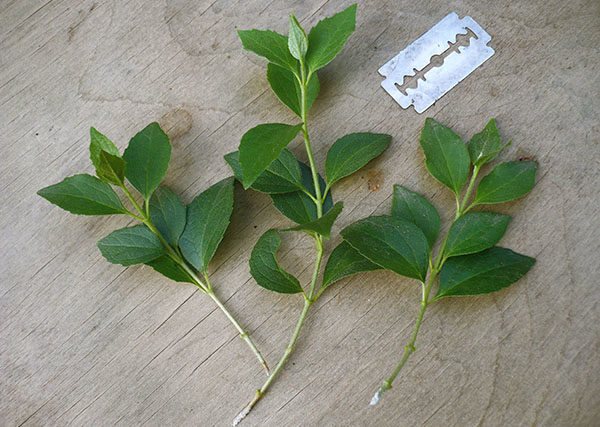

Jasmine is unpretentious, it tolerates pruning well and quickly recovers from it. The procedure can be carried out throughout the season; in the spring, frozen shoots are cut off, thickening in summer. After the end of the flowering period, not fallen buds are removed. As for sanitary and anti-aging pruning, it is most often carried out in the fall. Extra shoots are removed, as well as those that will no longer bloom so luxuriantly. Pruning in the fall is believed to help prepare the jasmine for the cold weather. Also, in the fall, fertilizers are applied before or after pruning, they will help restore the bush of strength after flowering.
Pruning hydrangea
When to prune a hydrangea
- Back to
- Forward
After this article, they usually read
To be honest, this year I was not going to make a rejuvenating pruning of a mock-orange, but circumstances developed so that my bush got sick and there is no joy to look at it half-dry and half-withered, and therefore I will tell you about rejuvenating pruning and about the history of my mock-orange.
In fact, looking at him before trimming him, none of you would say his correct age. And all because in the first years it did not grow at all and was strongly oppressed by weeds (add sandy soils to the reasons) and only in 2012 I took it up - dug it up and thereby allowed it to grow and become competitive with weeds. In 2013 we saw the first bloom, and in 2014 it was unusually lush.
But let's go back to today. So, chubushnik is a plant of the second pruning group, that is, it blooms on the overwintered growths of the previous year. But not all branches can overwinter. Firstly, weak and too briskly grown branches may not overwinter; they also often remain dry and small growths on branches that are too old, therefore, if the mock-orange is not cut for a long time, a mass of dry branches will begin to be seen in it. As an example, I can cite a bush near our Kalyazin five-story building, which grandmothers do not allow to cut off (this is generally somewhat funny - you can't cut a mock-orange, we spoil the bush with vandals; you can't cut an apple tree, a sacred tree is a sin; well, at least sick cherries are allowed to be cut out by services). Well, as a matter of fact, as you wish, dear grandmothers.
But we again moved away from the topic, back to cropping. July is the time for pruning the mock-orange, since in a normal summer it already fades, if the summer, like the current one, does not differ in normality, then pruning is done after flowering.
I will make a reservation right away, and without pruning, the bush can live for a very long time, since the short-lived branches dry out within several years, and the new growth of both the bush as a whole and on the old branch covers the dry areas of the branches and branches completely. So, the bush can remain attractive for decades, until the young growth ceases to be intense and dries out on its own, for example, due to weather conditions. Of course, with the loss of young growth due to the old age of the bush, the splendor of flowering also decreases.
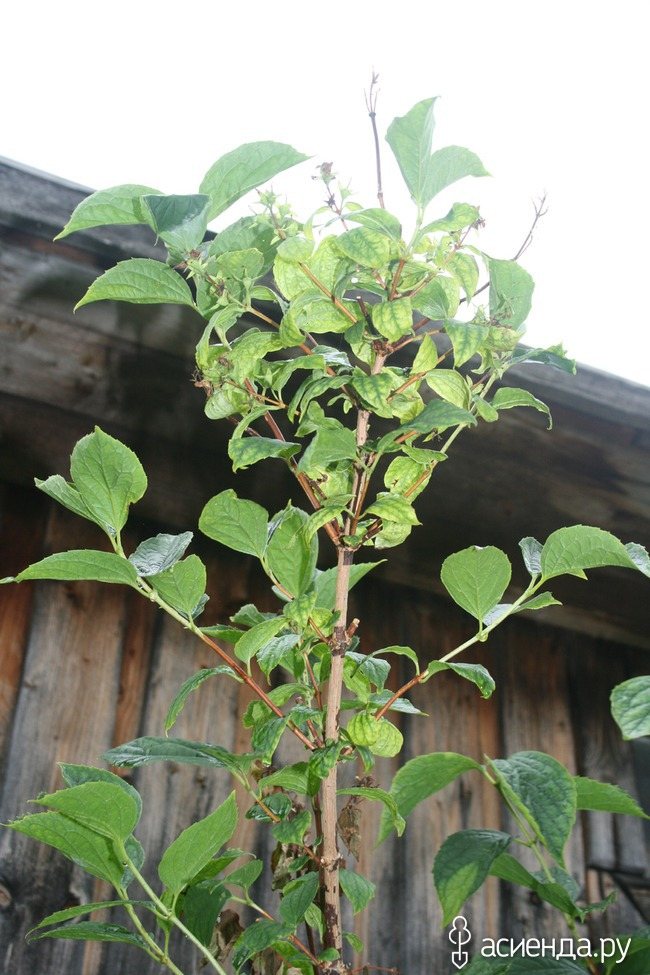

old branch, but with a young growth
a branch that will bloom in full bloom next year
To keep the bush in good shape, it is necessary to cut out several old branches at least once every couple of years, while you can cut it out not into a ring, but partially.I thought for a long time how to identify these very old branches, when you are under such a huge bush like in our yard, my narrow bush helped in this matter. When I took off the honeysuckle, I saw completely dry branches - they were the thickest about 5 cm in diameter, they did not give out themselves in any way.
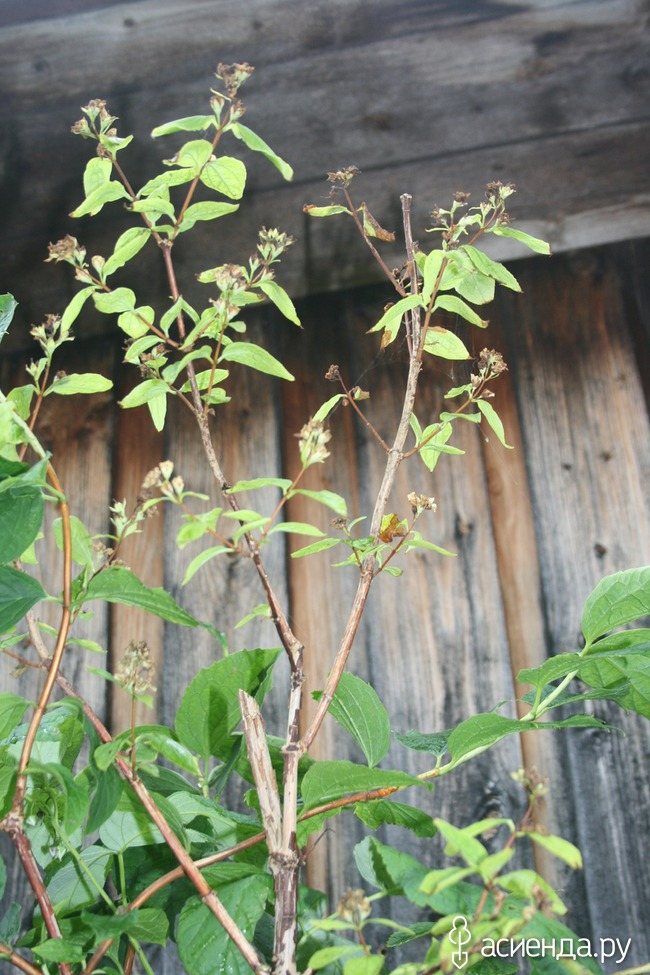

this is what the old branch looks like at the top - there is no young growth.
Well, and, of course, we also make cosmetic pruning - we cut out the dry branches, which I mentioned above, weak tops that obviously won't ripen by winter to survive it. As an example tops that did not survive this winter.
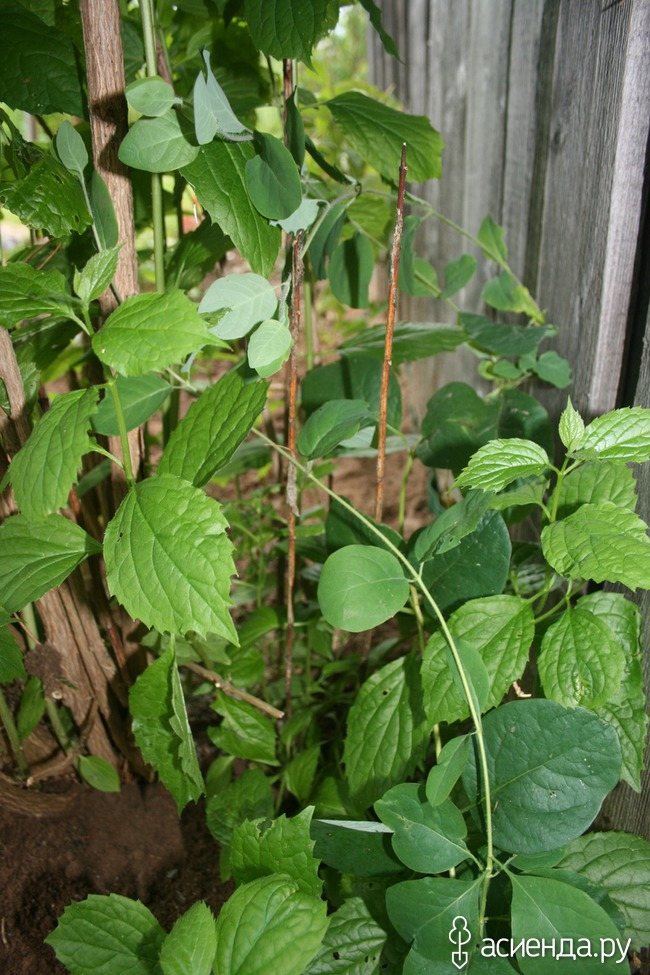

Some experts recommend cutting out faded branches to a strong young branch on the fork, which, in principle, makes sense for the youth of the bush, since in the fall the young branch will ripen and give side branches, which will bloom next year. But in principle, there is a young growth on a faded branch and such pruning will be very dramatic.
Due to the fact that my bush is sick, the pruning is not correct, I will leave the tops (perhaps what will survive), cut out diseased branches without growth, and also branches directed to the barn door (according to the law of meanness, healthy ones).
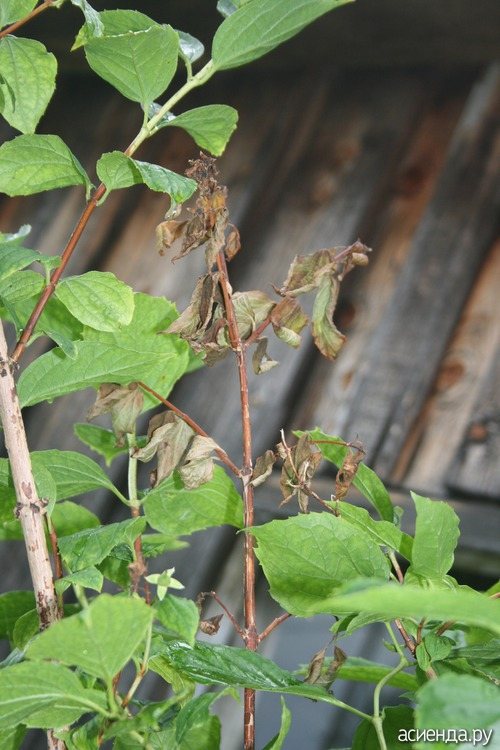

By the way, I contributed to the formation of these tops myself, disturbing the root system in search of a shoot in the fall. There were many branches leaving the bush, but there were no roots, in the end I took a branch with almost no root, but it took root in a new place, and these tops appeared in the place of its excavation. Perhaps they were weak because of the weeds.
You can also shape the bush now if you want to make a hedge or keep the bush at a lower height than its nature intended. However, you should not do a corrective pruning every year, otherwise we will not see flowering. Also, now you can cut out the "legs" if you like them "naked", although in some varieties "bare legs" come over the years. If, on the contrary, you like a lush bush, then you can only trim the tips of the lower branches, stimulating them to cover.
This is how my bush turned out, of course, this is by no means an example, since we remember that he was sick, just to show the result of my work.
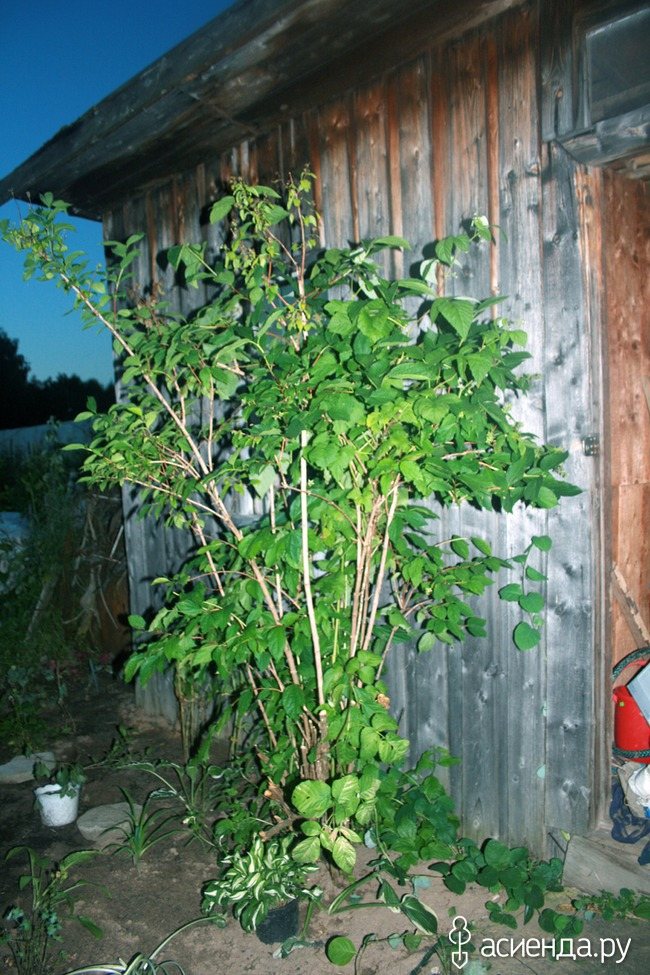

Well, so that our branches now have time to ripen before autumn and survive the winter, after pruning they need to be fed. For feeding, superphosphate or potassium phosphate, as well as wood ash, are suitable for us. I fertilized my bush with superphosphate, especially since I just spilled it on the porch.
Garden jasmine in the fall: pruning for beginners, rules for feeding, watering, features of cuttings
Often in garden plots you can find jasmine (chubushnik), since it easily tolerates frosts, lack of light, grows quickly, is well accepted after transplanting and does not make it difficult to care for. In addition, jasmine exudes a stunning scent.
Growing problems
Despite the unpretentiousness of the plant, every gardener is faced with force majeure from time to time. In order not to lose the bush, as well as continue to enjoy its appearance and aroma, you need to be prepared for such situations and know what to do.
Pay attention to the information on how to get rid of black aphids on jasmine.
Why do the leaves turn black
It happens that the foliage on the jasmine bush begins to turn black and curl. Many summer residents are afraid of fungal diseases, however, the problem lies elsewhere. Often, especially inexperienced gardeners, trying to do the best for the plant, apply too much fertilizer, which spoils the root system.
A way out of the situation will be to add a biostimulant to the soil: for example, for 10 liters of water, only one ampoule of "Zircon" will be enough.
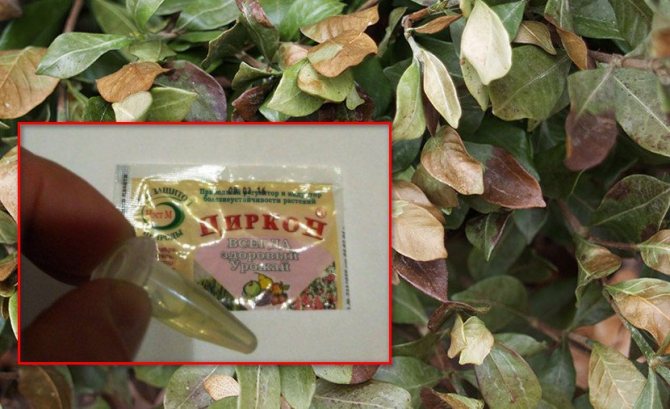

Causes of yellowing of leaves
The most common reason for yellowing leaves is insufficient watering or nutrients in the soil. In the latter case, additional fertilizing may be required, which contain nitrogen in their composition. Drying of the leaves can provoke a fungal disease (for example, gray rot) or a too deep root collar.
In the first case, it is recommended to carry out systematic preventive treatment with the participation of fungicidal and insecticidal preparations (depending on the type of disease), in the second, to free the bush at the base from excess soil with the onset of spring.
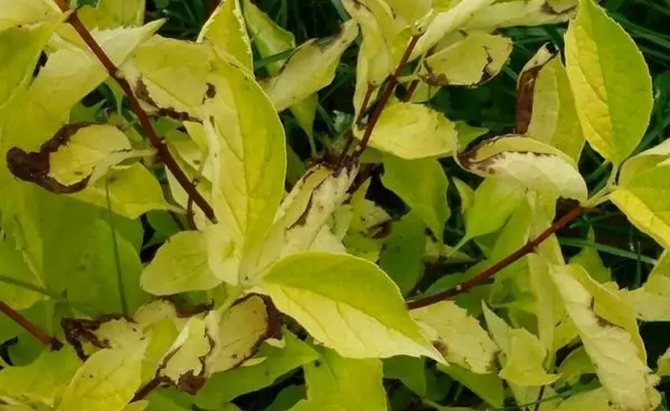

The appearance of pests
Jasmine is rare but can be attacked by various types of insect pests. The most common of them are:
- Spider mite - a small insect (no more than 5 mm), which, feeding on plant sap, entangles its foliage with cobwebs. As a result, small spots of light yellow color can be seen on the surface of the plant. To combat the pest, the bushes are treated with acaricides or insecticides, at least 2 times, at intervals of 10-14 days.
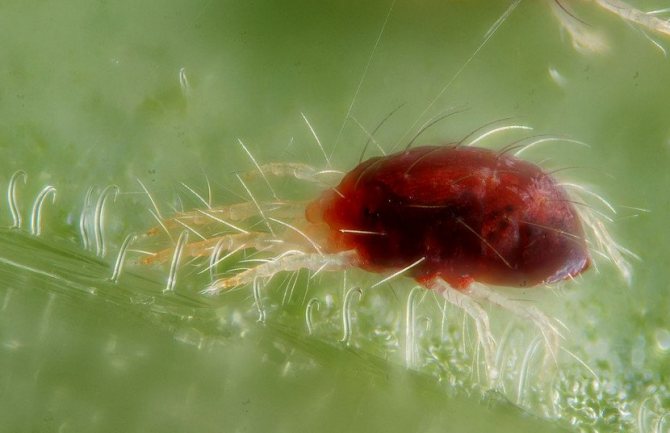

- Weevils - small beetles, which, despite their size, can lead to the destruction of an entire plant. In order to get rid of pests, jasmine is processed with chlorophos, and with a small number of pests, insects, and their larvae, they are collected and destroyed by hand.
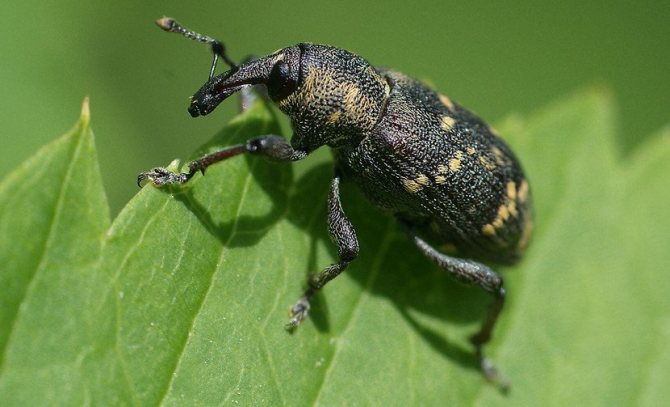

In general, jasmine belongs to plants that do not require careful maintenance. Sufficient watering and annual feeding will provide the garden with a beautiful flowering shrub that will delight you with its exquisite aroma for a long time. One should not forget about timely pruning, because this procedure not only makes it possible to get the desired shape of the bush, but also acts as a prevention of various fungal diseases, which, if they occur, can easily spread throughout the entire area.
CARE RULES FOR JASMINE AUTUMN
Deciduous shrub is commonly used for landscaping. In nature, there are more than fifty species of garden jasmine and a large number of cultivars.
How to fertilize jasmine in autumn
A flowering plant is not demanding on the characteristics of the soil, but in the absence of nutrients and insufficient air and moisture permeability, its growth and flowering will become noticeably worse. Heavy clay soil should be supplemented with strong drainage. Replace part of the sandy loamy sand with garden soil.
Experts recommend feeding jasmine no more than once a decade. Organic and mineral fertilizers must be applied throughout the year. Best in liquid form. You should start feeding the plant with products containing minerals in the third year after planting.
In autumn, after flowering is complete, jasmine needs additional feeding, which will give strength for a successful wintering. It is necessary to prepare a mixture of the following substances:
- wood ash (100 g);
- potassium sulfate (15 g);
- superphosphate (25 g).
For a lush color, jasmine should be fertilized with organic compounds. Add a manure solution diluted in a ratio of 1:10 under each plant. After the end of flowering, it is necessary to scatter 20-25 g (1 tablespoon) of superphosphate and 10-15 g of potassium sulfate per 1 sq. meter. Mineral fertilizers under the chubushnik are applied in September. If pellets are used, they should be scattered into damp soil and tamped down a little.
How to trim jasmine (video)
Jasmine autumn watering mode
Chubushnik is very picky about the presence of moisture. Do not allow it to dehydrate, and also make sure that no stagnation of water occurs. It is especially important to adhere to a watering schedule before flowering shrubs.
Yellowed and lethargic leaves indicate a lack of moisture in the soil. Watering should be done abundantly, but not overwhelm the plant. The water must first be defended. It must be warm, otherwise the jasmine can get sick. Since the end of July, the watering of the bush has been reduced. It is required to pay attention to the condition of the earth so that it does not dry out, but it is also important not to flood the bush. After each watering, the soil surface must be loosened and weeds removed as they grow.Rhizome weeds, such as leek and dandelion, have a particularly negative effect on jasmine.
Scheme and technology for pruning jasmine in the fall for beginners
The dense crown of the shrub requires regular pruning, which is done every year, otherwise the old branches will overwhelm the young shoots, and the shape of the bush will take on a sloppy look. The most suitable time for the procedure is autumn. During this period, the growing season ends, and the plant prepares for winter rest. An important condition for autumn pruning is that the temperature is above -10 ºC, otherwise fragile wood is easily injured under the influence of frost.
Tools required for work:
- secateurs;
- lopper;
- saws and hacksaws;
- putties (special preparations sold in specialized outlets, garden variety), which protect the shrub from drying out and infections at the cut points.
Pruning is done to achieve two goals: shortening (creating the shape of the bush, regulating flowering, limiting intensive growth) and thinning (rejuvenation and sanitation). In autumn, as a rule, the plant is thinned out or rejuvenated.
As a result of pruning, the plant is freed from old, twisted, dried up and diseased branches. Rejuvenation of the crown leads to the active growth of abundantly flowering branches. Neglecting the procedure threatens that in a couple of years the jasmine will stop blooming.
How to propagate a chubushnik (video)
Autumn top dressing of chubushnik
You can fertilize jasmine in the fall with the help of organic and mineral dressings. You can use the following options:
- chicken, cow or horse manure, diluted with water 800-900 g of manure in a 10-liter bucket;
- compost and humus in the same ratio: about 10-15 kg per 1 bush, depending on its size;
- superphosphate and potassium sulfate, taken in the same ratio (concentration and method of obtaining a solution - according to the instructions).
All fertilizers are applied only on a warm day without rain. First, you need to water the bushes abundantly, wait until the moisture is absorbed into the soil, and then apply fertilizer.
FEATURES OF JASMINE BREEDING BY CUTRINGS IN AUTUMN
Chubushnik can be propagated in three ways: using seeds, cuttings and division. Since grafting shrubs is the easiest to do, especially for the novice gardener, this method is the most popular.
Principles of jasmine cuttings
Propagation by green cuttings guarantees one hundred percent rooting. But you can also use lignified cuttings, the rooting method of which is identical to green cuttings.
After the end of the growing season, it is necessary to choose a developed, but not very wide shoot, since putrefactive bacteria can develop in the hollow core, which will lead to the death of the cutting. A one year old shoot is best. It is recommended to cut the cuttings together with a small piece of old wood. It is undesirable to take branches with long internodes. One 5 cm cutting should have 1-2 internodes and 2-3 pairs of leaves. In order for the planting material to take root better, the cut should be oblique from below, and straight above the kidney.
In the spring, the harvested material must be removed from the storage sites, cut the cuttings and planted for rooting, having previously been treated with special stimulants.
Storing cuttings until spring
It is necessary to plant the material in early spring, after making small indentations with a thin stick. Cuttings should be placed obliquely, deepening to the level of the upper buds. To improve contact with the soil, the cutting should be gently squeezed with your fingers.
After 1-1.5 months, the first roots will appear. After the start of the growth of the shoots, the cuttings should be spud. During the warm period, they need special care. Young seedlings need watering, loosening and weeding. By the fall, you can see the appearance of a fibrous root system.
With the onset of cold weather, the seedlings need to be dug in, and in the spring, to form the shoots, cut the aboveground part onto a stump. Plant in a permanent place in early autumn.
The subtleties of growing
Despite the general unpretentiousness of this plant, the cultivation of jasmine may require adherence to some agrotechnical rules. First of all, this concerns the choice of location, soil preparation and adherence to the planting scheme. It is from these factors, as well as subsequent care procedures, that the appearance of the bush and its ability to bloom will depend.
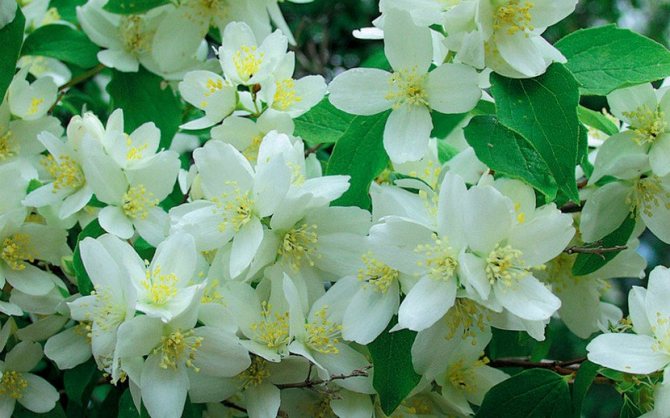

Choosing a landing site
When choosing the optimal place for planting, it should be borne in mind that jasmine does not show any particular demands on the soil, however, when planting it should be pre-prepared by increasing the structure and ensuring drainage. It should also be taken into account that although the shrub will grow well in shaded areas, its inflorescences and leaves will be faded, and the aroma is not so pronounced.
Did you know? Not all varieties of jasmine have a scent, and therefore, before buying or harvesting seedlings on your own, you should clarify the type of future bush.
The best option would be the ability to at least periodically receive sunlight. Jasmine's healthy growth and development requires a lot of space, so don't plant it close to other plants. And it is better to avoid drafts and places that are blown by northern winds, as well as lowlands with a close occurrence of groundwater.
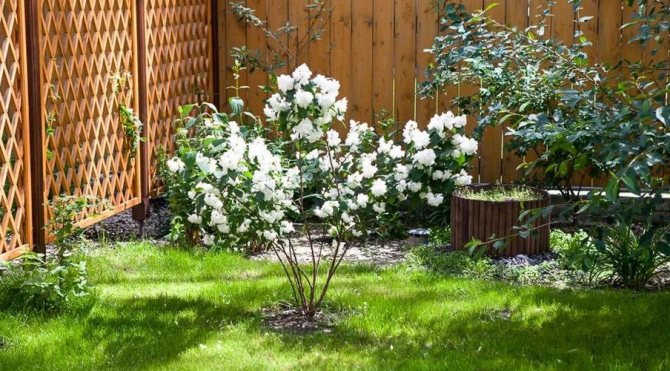

Soil preparation
Experienced gardeners prefer to prepare the soil before planting a shrub. The soil is pre-dug up to 20-30 cm, after which the planting pit itself is prepared, measuring about 50 × 50 cm. The bottom of the hole is laid out with a drainage layer, about 10 cm high. In this case, you can use natural materials such as broken brick, gravel, crushed stone or sand.
Also find out how the mock-orange differs from jasmine.
Additionally, the soil from the planting pit is fertilized by adding nitrophoska (30 g per plant). The optimal time for planting is considered either early spring (before the leaves bloom), or the beginning of autumn.
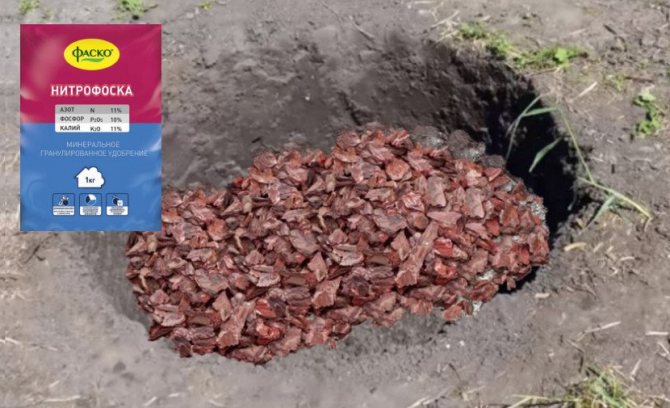

Landing scheme
The distance between the planted jasmine bushes directly depends on the desired result:
- for group planting, the planting pits are located at a distance of about 1-1.5 m from each other;
- in the process of creating a hedge, this distance can be reduced to 0.5 m.
Pay attention to the information on why jasmine does not bloom and grows poorly.
HOW TO PREPARE JASMINE FOR WINTER CORRECTLY
Many varieties of chubushnik do not require special preparation for winter, because even in case of freezing of annual shoots, the crown will be restored after spring processing. Adult specimens tolerate low temperatures well.
Young seedlings are less resistant to winter cold. Shrubs less than a year old must be covered with a strong cold snap. Any covering material and a rope for fastening are suitable as insulation.
The ground around the plant must be dug up and covered with mulch. You can use garden compost, paws of coniferous trees or fallen needles, manure. These simple actions will save the root system from freezing.
How to care for a mock orange after flowering and in autumn
What to do with garden jasmine after flowering and in the fall, in preparation for winter:
- prune after flowering:
- feed;
- if necessary, carry out an autumn anti-aging pruning;
- prepare for winter - mulch the trunks of young bushes and tie the old ones.
By the way! In the fall, you can also transplant chubushnik to a new place... It is quite simple to do this, the technology is as follows:
- Dig in the shrub from all sides, stepping back from its center.
- Take a long, but not very wide board.Push one end of the board with effort under the root from below, and press the other end like a lever. This will remove the bush with minimal root damage.
- Before planting, spill the hole well with water and plant a bush (you can just below).
- Cover with soil and water again abundantly.
- Cover the top with dry soil, peat, compost.
- If the bush is large, then cut it off.
Autumn care for garden jasmine: pruning and other activities
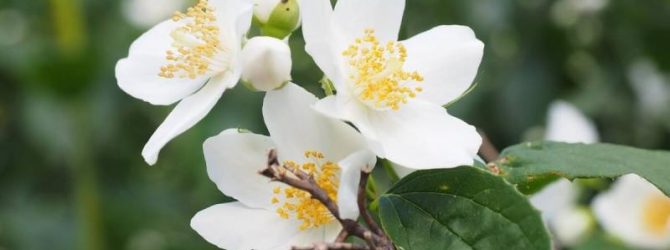

Garden jasmine, or, as it is more correct to call it, chubushnik, is valued by gardeners for its abundant spring flowering and a pleasant aroma exuded by numerous flowers. The shrub is unpretentious and not capricious, but in order to maintain its decorative effect at the maximum level, it must be looked after during the entire growing season, including in autumn.
Formative pruning
Spring is the perfect time to form jasmine and grow a beautiful bush. If you leave it to its own devices, you can get a not very beautiful result - both one-sided shrubs and tall (more than 2 m) trees, which will be difficult to care for.
In the spring of planting the chubushnik should be carefully trimmed by cutting off the branches that are too long and protruding beyond the bush. In addition, formative pruning is the basis for a jasmine hedge. In this case, the strong old shoots should be lightly pruned and the young and thin branches removed to stimulate the formation of annual shoots.
Spring Pruning Jasmine Video
Garden jasmine is an unpretentious culture. But in the absence of care, old and injured branches do not allow new shoots to grow. They become a source of disease and a haven for pests. The plant loses its decorative qualities. To prevent this from happening, it is necessary to cut the crown in a timely and correct manner.
Crown formation
With the help of formative pruning, the crown of the garden jasmine is given the desired shape. Specimens growing rapidly upward are limited in height, and their crowns are thinned out. This pruning is done at the end of March. Carry out it as needed. If the plant gives a relatively small increase and retains its decorative appearance for a long time, the formation of the crown is carried out once every 3-4 years.
With a high density of the crown, 3-4 of the oldest branches should be cut from the middle of the bush. They give little growth and interfere with the development of the whole plant. Remove them by sawing out at ground level. Thick branches going into the crown must also be removed.
Very tall jasmine bushes in the garden do not look aesthetically pleasing.... To limit their growth, you need to half-cut all branches pointing up. The lateral shoots growing after such pruning will form many buds in the upper part of the bush.
Jasmine's ugly outlines are also easy to fix. To give the plant a uniform and regular shape, you need to shorten the largest and longest branches by cutting them in half. The rest of the shoots should not be shortened in order to get an abundantly flowering bush this year.
Why prune jasmine, what is the difference between autumn and spring pruning?
When growing ornamental shrubs, a novice gardener may find it difficult to prune jasmine. In the fall or spring, to carry out this work, at what age to start, what shape to give the plant - these and many other questions sometimes do not find an answer. Don't worry, this is an unpretentious plant, caring for it is simple. The first time may turn out to be unsuccessful, the shape of the bush will be uneven, but do not give up. Take into account the mistakes and repeat the procedure after six months. Each time you will gain experience, and after a while you will be able to compete with a professional landscape designer.
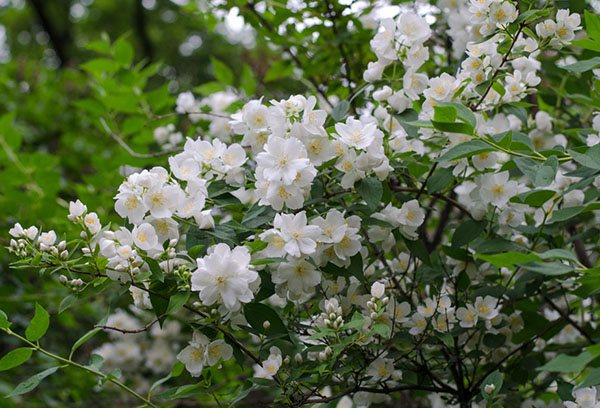

Types of chubushnik
Chubushnik or garden jasmine has many types and varieties bred by breeders.If you want to grow this highly decorative plant on your site, then you should pay attention to the most unpretentious varieties.
Crown mock
This type of mock-orange is also called ordinary. The species is most commonly grown in our gardens. Chubushnik crown differs in unpretentiousness, lush flowering, delicate aroma of flowers. This type is very popular with landscape designers, since they can perfectly decorate the background of any flower garden, lawn. Chubushnik of this variety reaches a height of 3-3.5 m, and in diameter it can be more than 2 m.
The crown mock-orange begins its flowering in May. Cream-colored flowers completely cover the shrub, and fill the air with a heady, slightly sugary aroma. The species blooms for just over a month. Crown mock-orange is especially common in the southern regions of Europe. This species, due to its varietal qualities, tolerates winter very well, which is why it demanded the love of domestic florists. Also, the crown mock-orange can endure the period of strong winds in winter almost without damage. The species is not picky about the composition of the soil and lighting - it can even put up with a shadow. Distinctive features of the crown mock-orange are pointed light green leaves and shoots with a reddish bark.
Jasmine virginsky
As a result of crossing the species of the crown and small-leaved species, the Virginia species was obtained. This species reaches a height of 3 meters, has a very dense crown of brown shoots. The foliage of Virginia jasmine is oval in shape, the leaves reach 8 cm in length. This species begins to bloom in the middle of summer, blooming large inflorescences of double, snow-white flowers, exuding very pleasant reinforcement. The diameter of the Virginia jasmine flower can reach 5 cm. Sometimes this species blooms even in September under favorable conditions.
Chubushnik tolerates pruning procedures quite easily, so you can form a bush or a live jasmine hedge, shortening the shoots, in any month during the summer season. In the spring, parts of the plant damaged during the winter period are removed - broken branches and frostbitten young shoots.
Sanitary pruning of jasmine in the fall is the most important, and therefore the most important.
Its main goal is to prepare the shrub for wintering. In order for the culture to calmly survive the cold, all old branches should be carefully cut down. They will no longer bloom, but take most of the energy and strength of the plant, absorb nutrients from the soil.
Formative pruning is needed not only for the chubushnik, but also for indoor jasmine growing in a flower pot.
Pruning after flowering
After flowering jasmine, it is also necessary to prune the bushes. Firstly, it helps to maintain their decorative effect in shrubs, since the purpose of this procedure is to remove wilted inflorescences. Secondly, pruning jasmine after flowering contributes to the formation of a lush bush, since all varieties of this plant, especially vigorous ones, can grow one-sided under uneven lighting.
The procedure is done with a sharp instrument, while the withered flowers are cut off. In this case, it is not necessary to carry out processing of the cut site. Also cut off too long shoots, spoiling the decorative effect of the crown of the bush. At the same time, you can perform another sanitary procedure. To do this, examine the bush, remove all weak and diseased shoots, broken branches.
Spirea pruning
When to trim spirea
The timing of the autumn pruning of spirea depends on the timing of its flowering:
- Brunner: planting and care, growing from seeds
- for varieties of spirea that bloom in late spring or early summer, pruning in September is optimal if you did not start doing this summer, immediately after flowering. Early flowering species include spirea Vagutta, sharp-toothed, medium, nippon, oak-leaved;
- late-flowering spirea, which includes Japanese spirea, Bumald, Douglas, Billiard, willow, birch-leaved, pruned in spring.
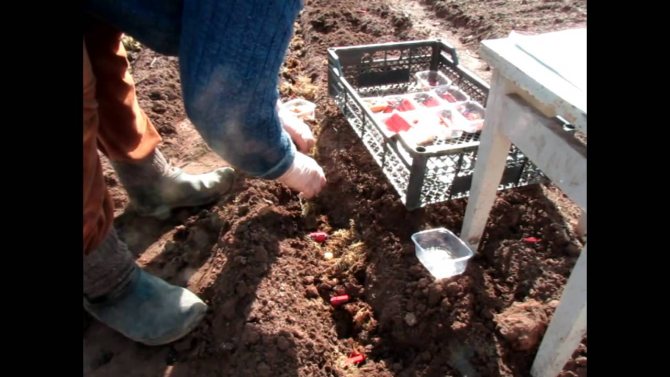

Pruning spirea in autumn
After the early flowering spirea has faded, cut off the faded tops of the shoots to maintain the natural shape of the crown until the end of summer. With the onset of autumn, so that the bush does not lose its decorative effect in the future, a fourth or fifth of all shoots are removed from it at the root - this measure stimulates the growth of shoots next year. If possible, remove all faded shoots, leaving young shoots. Spirea bushes are thinned every two to three years, cutting out crooked, too thin and weak branches.
Once a decade, if there is no need to do this earlier, the spirea is cut thoroughly, leaving only 5-7 young strong branches on the bush.
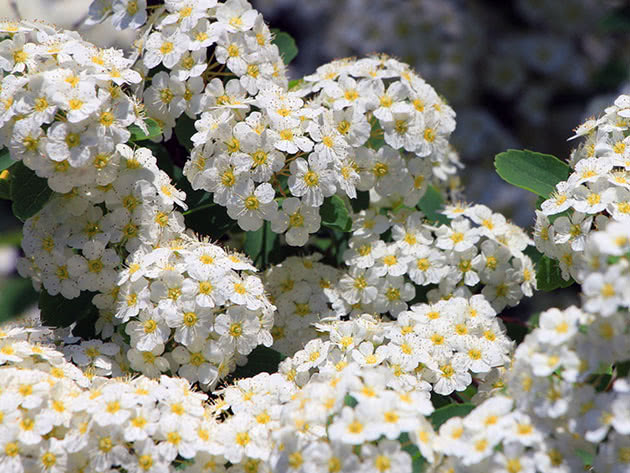

Pruning hibiscus
When to prune hibiscus
The hibiscus shrub needs to be pruned annually, and since hibiscus garden flower buds are formed on the shoots of the current year, by pruning, you stimulate the formation of a large number of new flowering shoots. Hibiscus pruning is carried out either on the eve of winter, or at the end of it.
Pruning hibiscus in autumn
If you are pruning in the fall, thin out the hibiscus bush by removing any damaged, diseased, weak, and growing shoots. In the spring, it will remain for you, if the need arises, to carry out formative pruning, shortening the overwintered shoots.


Thinning reasons
Crown rejuvenation results in abundant, healthy flowering and development. Inevitably, you will have to get rid of the branches that are not useful and effective, because: they have already outlived their (old), damaged, broken. The branch can actively bear fruit for no more than five years. The bush should not be very thick or thickened, this makes it messy and extremely awkward. Thinning makes it possible to keep the twigs in the same length, the shape looks attractive, jasmine fascinates with the beauty of well-groomed.
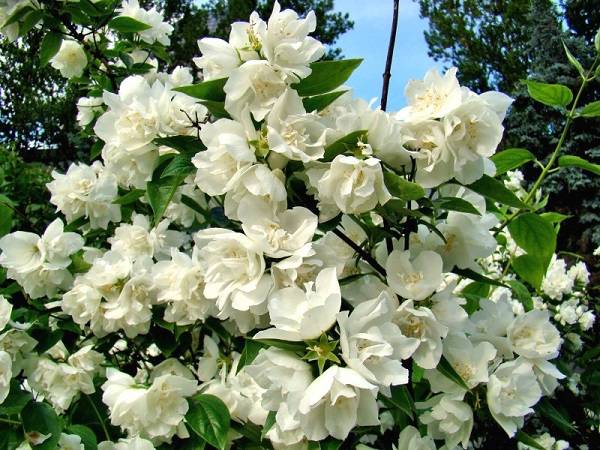

Sanitary pruning
The main pruning of the chubushnik is carried out in the spring to improve the appearance of the shrub. Most often this is done before bud break in the middle of the first spring month, but dead shoots can be cut out before flowering.
What does sanitary pruning include:
- removal of frozen shoots (if the crown is strongly thickened) or their parts (cut to live wood);
- shortening of broken branches: here it is important not to forget that pruning most of the shoots negatively affects the splendor of the summer flowering of the chubushnik.
When carrying out sanitary pruning of garden jasmine, it is necessary to view the crown for excessive density and decorativeness. For dense bushes of an ugly shape, it is advisable to combine a sanitary procedure with a formative one.
Cut dry and broken branches throughout the summer. For sanitary purposes, jasmine is also cut in the fall when preparing the plant for winter.
Jasmine (shrub): planting and care, photo, pruning
To grow a neat and beautiful plant, it is important to know and follow some agricultural techniques:
- Jasmine tolerates shade well, so it can grow both in the sun and in shaded areas. But a plant planted in a well-lit area will develop much faster and bloom more abundantly.
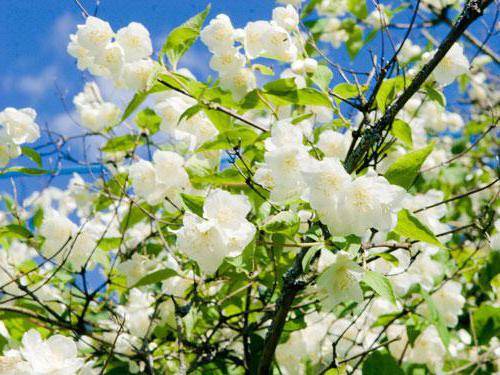

- Planting seedlings can be done in early spring or autumn. These are favorable periods for the rooting and development of young bushes.
- The plant is not picky about the soil, but it can only open up in all its glory on fertile soil.


- Jasmine does not tolerate stagnant water, so it is recommended to plant it in a high area, or to do preliminary drainage from rubble and sand, gravel or broken brick at least 15 cm high.
- A pit for planting a seedling is dug out at least 50 cm deep. The soil must be fertile enough. It is desirable to introduce nitrophoska (30 g).When planting a plant, it is important to ensure that its root system is buried no more than 3 cm into the ground. The ground around the bush should be tamped and watered abundantly.
We carry out the procedure according to the rules
The first thing to do is to make sure that the garden tools used for pruning plants are well sharpened. This is important, as the dull blades of the tools can damage the shoots and will not allow you to make a neat, even cut. To cut old branches in the fall, you will definitely need to use a hacksaw - the pruner will not cope properly with this work.
Step by step scheme:
- 1. All damaged and dried shoots are cut off, and then old branches thickening the bush and incapable of flowering. Usually these are stems that have reached 5 years of age.
- 2. Jasmine is given the desired shape by shortening plant fragments in those places where they go beyond the established boundaries of crown development.
- 3. Withered, but not fallen inflorescences should also be carefully cut off.
If, in the process, serious cuts appeared with a surface whose area exceeds 2-3 millimeters, it is recommended to treat them with garden varnish in order to prevent infection with fungus or freezing during the first frosts. The procedures are carried out strictly before the air temperature drops to -8-10 degrees.
In addition to autumn pruning, before the onset of the vegetative dormancy period, jasmine needs to be fed with phosphorus-potassium fertilizers. This can be, for example, wood ash and a portion of superphosphate indicated in the manufacturer's annotation.
Formative pruning is an important part of the care of jasmine bushes. If the chubushnik was unevenly illuminated during the summer period, then by autumn its symmetry may be broken due to the unevenness of the crown density. To fix this, you need to shorten the shoots on the thickened side of the plant.
In order for weakened shoots not to shade strong branches, they are shortened by 1/2 length. E
If they do not play any role in the formation of the crown, they can be cut off completely. In this case, the plant will be able to release many new strong shoots.
New jasmine hedge advice for novice gardeners: shorten any available shoots slightly each time. This stimulates the growth of the green part of the shrub, and it is completely covered with foliage.
You can create a wide variety of shapes from chubushnik bushes - balls, pyramids, cones, animal figurines - they are easy to shape. The only thing, it is important to cut off the branches that go beyond the boundaries of the shape in time - they give the plantings an unkempt look.
Pruning jasmine and forming the crown of the plant
Garden jasmine, or chubushnik, is an unpretentious plant. A minimal care is enough for it to please with exuberant flowering every year.
For the growth and development of the bush, watering, feeding and pruning are necessary. Pruning is one of the most important and mandatory procedures. There are several types of pruning that need to be done regularly. Without this, the flowering of jasmine will be scarce, and then completely stop.
In this article, we'll look at when to prune jasmine and how to do it right.
Jasmine: grooming and pruning
When growing jasmine, pruning is an important process: it gives the plant a neat and tidy appearance and helps the bush to look healthy and lush. The first pruning is done immediately after planting the seedling. On the bush, remove all shoots that are located incorrectly, leaving only two or three branches with several strong buds. Everything else is cut out.
Jasmine is not a winter-hardy plant and needs warmth. In regions with more severe climates, the bushes freeze slightly every winter, and many spoiled, dry branches appear on them. That is why spring pruning of jasmine is carried out after winter. It is done only with a sharp instrument. A quality pruner is perfect for these purposes.
The need for timely pruning
Garden jasmine is appreciated for its decorative bush and fragrant flowers. A properly formed plant can beautify any garden or backyard. But in order to give it the necessary shape and make it bloom profusely, formative pruning is needed. After all, the chubushnik is distinguished by a fairly rapid and uneven growth. Without crown correction, it grows one-sided and asymmetrically. Plants over 5 years old are pruned.
In the spring, they carry out sanitary pruning of the plant. At the same time, all non-viable, dry or frost-damaged branches are removed. You cannot leave them, as they are a breeding ground for fungi and even harmful insects.
Particular attention should be paid to pruning the bush after flowering. This procedure is necessary to give the bush a compact and tidy look. It also contributes to the formation of a beautiful and evenly developed crown.
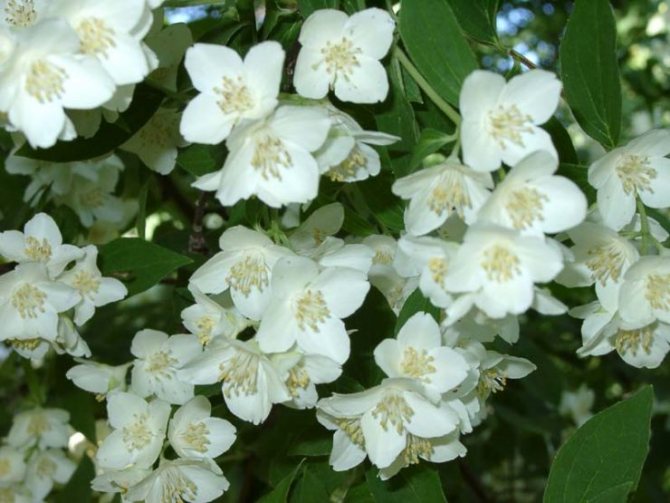

Very old plants or shrubs that are badly damaged by frost need rejuvenating pruning. This is a radical pruning of the plant that stimulates the rapid growth of young shoots. After such pruning, old bushes with bare branches quickly acquire an attractive appearance and bloom violently.
Instructions
Once every three years, you need to carefully examine the jasmine and get rid of old shoots, all branches must be less than ten years of age. Slices are processed with garden varnish. It is impossible to do without: thinning of shoots, sanitary, rejuvenating pruning, elimination of faded inflorescences. During the growing season - feed well, water abundantly, and mulch with compost. If, with the arrival of spring, only a few of the strongest shoots are left, and all the rest get rid of, the plant will become very beautiful in a year, and after three it will bloom profusely, it does not need special shelters.
The aroma of jasmine is well known to many since childhood. A huge, spreading, very beautiful bush with large star-shaped snow-white flowers as if beckons with its sweet, unique scent.
Taking care of this plant is simply a pleasure, since it does not require special attention. In order for jasmine to bloom magnificently and fill the garden with its delightful fragrant aroma, it is important to prune, water and fertilize.
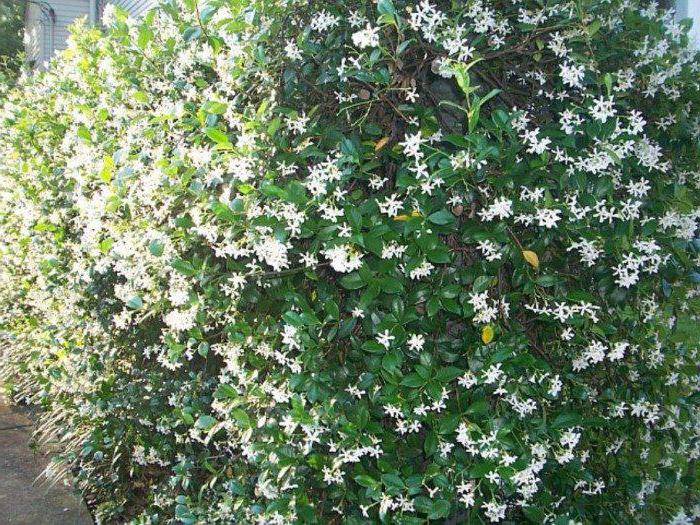

Anti-aging pruning
The presence of a large number of perennial bare shoots in the bush suggests that radical measures need to be taken. After all, these shoots practically do not give growth, few flower buds appear on them, and this worsens the appearance of the plant.
Correct anti-aging pruning of the mock-orange is done in early spring. This procedure is started when the plant reaches at least 12 years old and is repeated every 6-7 years.
The basic rules are as follows:
- sawed off all shoots that are more than 10 years old to the ground;
- cut dry, thin and poorly developing branches;
- choose the strongest young branches (4-5 pcs.), prune them, leaving 30-40 cm, and cut the rest completely;
- the places of the cuts are smeared with garden pitch.
After the procedure, the soil near the jasmine is mulched and watered with a liquid manure solution. Then they continue to moisturize well, so that the "operated" shrub recovers faster and gains mass.
During the current year, young shoots will grow on the left parts of the branches, which it is advisable to remove immediately. You can thin them out next spring, leaving several branches shortened to 30-40 cm (3-4 pcs.) On the main branches. During the summer, new branches will appear on the main part of the bush, which will begin to bloom the next summer.

